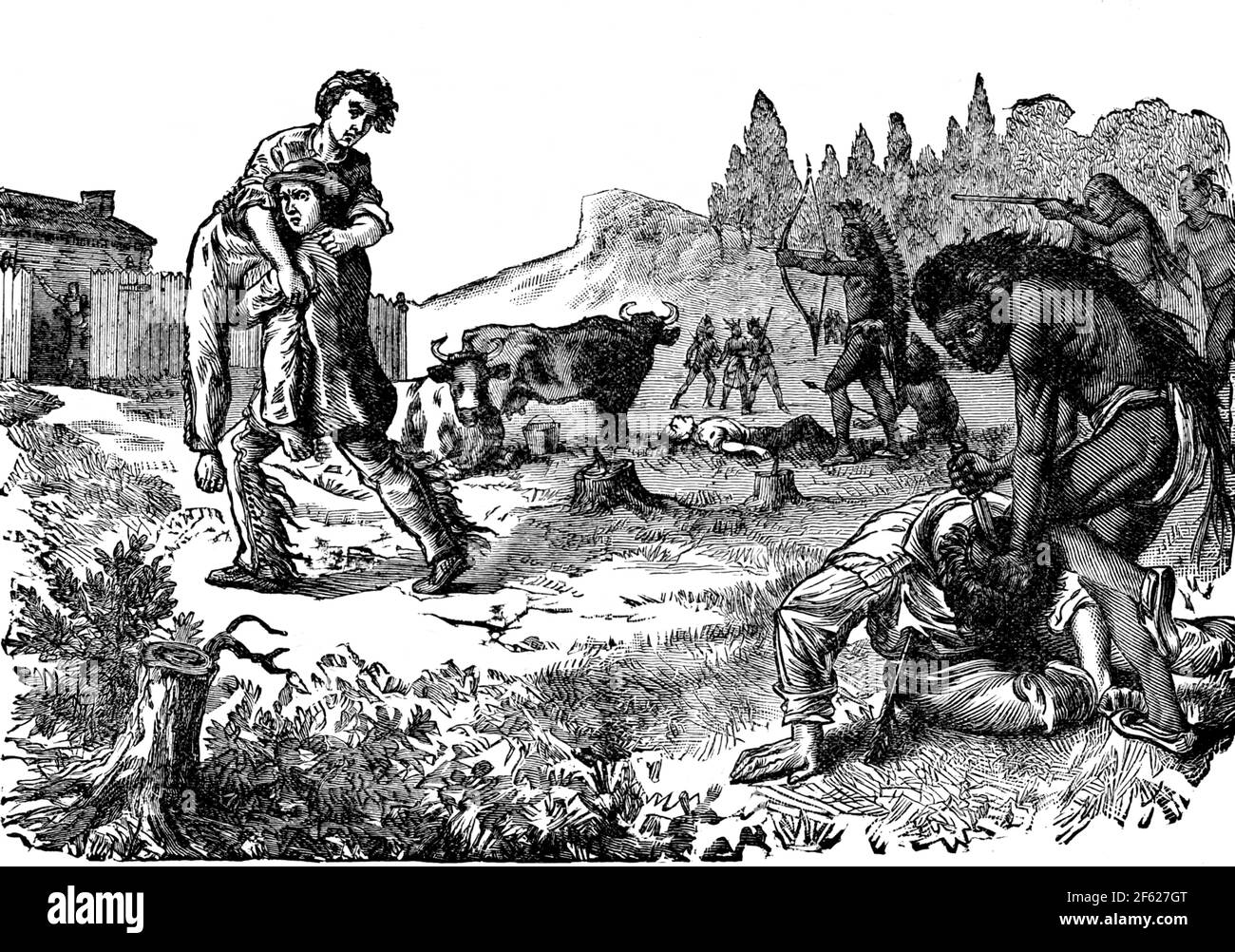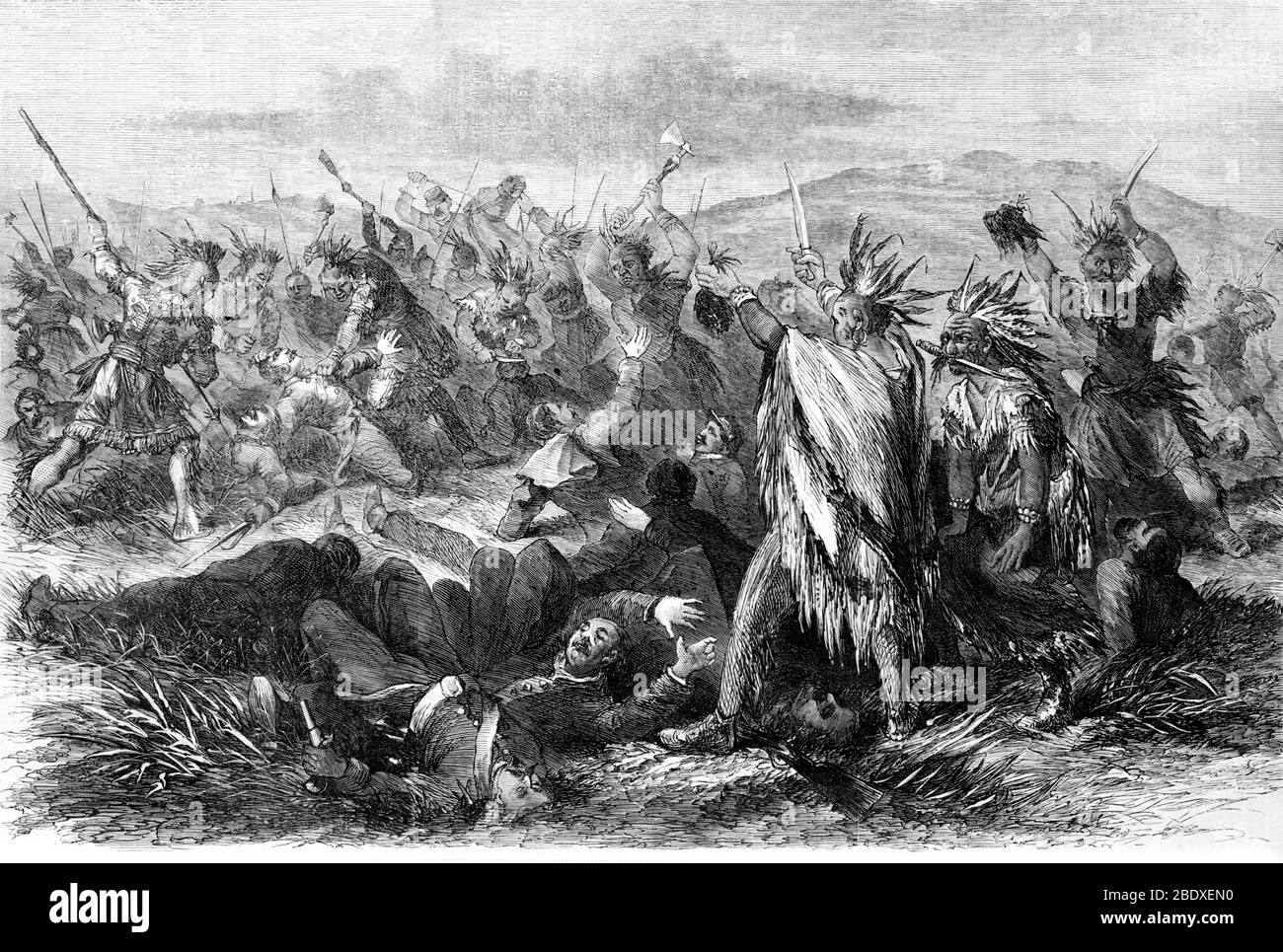Quick filters:
Scalping native american Stock Photos and Images
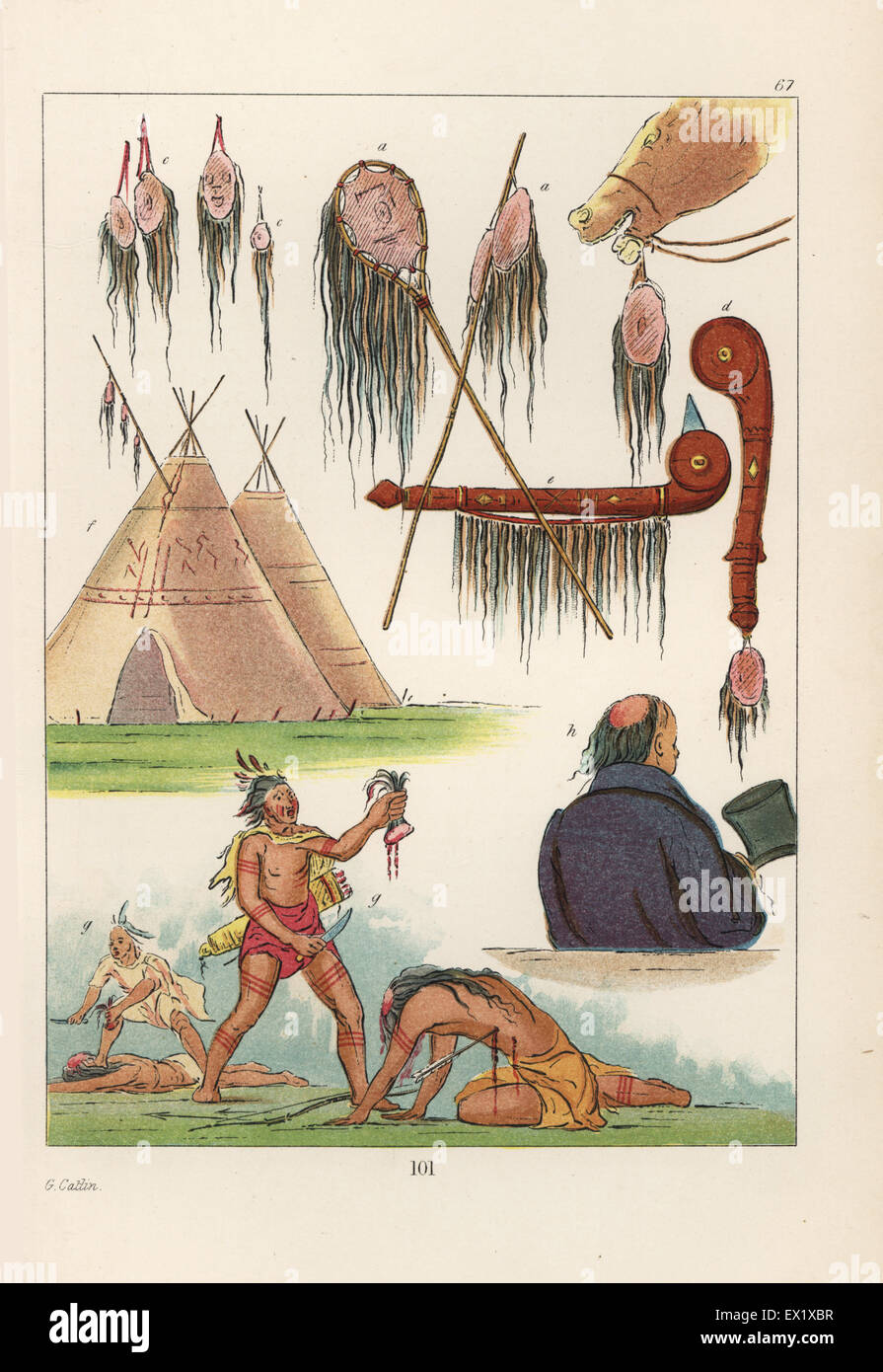 The practice of scalping a defeated enemy corpse by the Native Americans g, stretched scalps for a scalp dance a, small scalps c, scalp on a war club d, scalp pole on a teepee f and trophy on a bridle b. Man who has survived a scalping h. Handcoloured lithograph from George Catlin's Manners, Customs and Condition of the North American Indians, London, 1841. Stock Photohttps://www.alamy.com/image-license-details/?v=1https://www.alamy.com/stock-photo-the-practice-of-scalping-a-defeated-enemy-corpse-by-the-native-americans-84865195.html
The practice of scalping a defeated enemy corpse by the Native Americans g, stretched scalps for a scalp dance a, small scalps c, scalp on a war club d, scalp pole on a teepee f and trophy on a bridle b. Man who has survived a scalping h. Handcoloured lithograph from George Catlin's Manners, Customs and Condition of the North American Indians, London, 1841. Stock Photohttps://www.alamy.com/image-license-details/?v=1https://www.alamy.com/stock-photo-the-practice-of-scalping-a-defeated-enemy-corpse-by-the-native-americans-84865195.htmlRMEX1XBR–The practice of scalping a defeated enemy corpse by the Native Americans g, stretched scalps for a scalp dance a, small scalps c, scalp on a war club d, scalp pole on a teepee f and trophy on a bridle b. Man who has survived a scalping h. Handcoloured lithograph from George Catlin's Manners, Customs and Condition of the North American Indians, London, 1841.
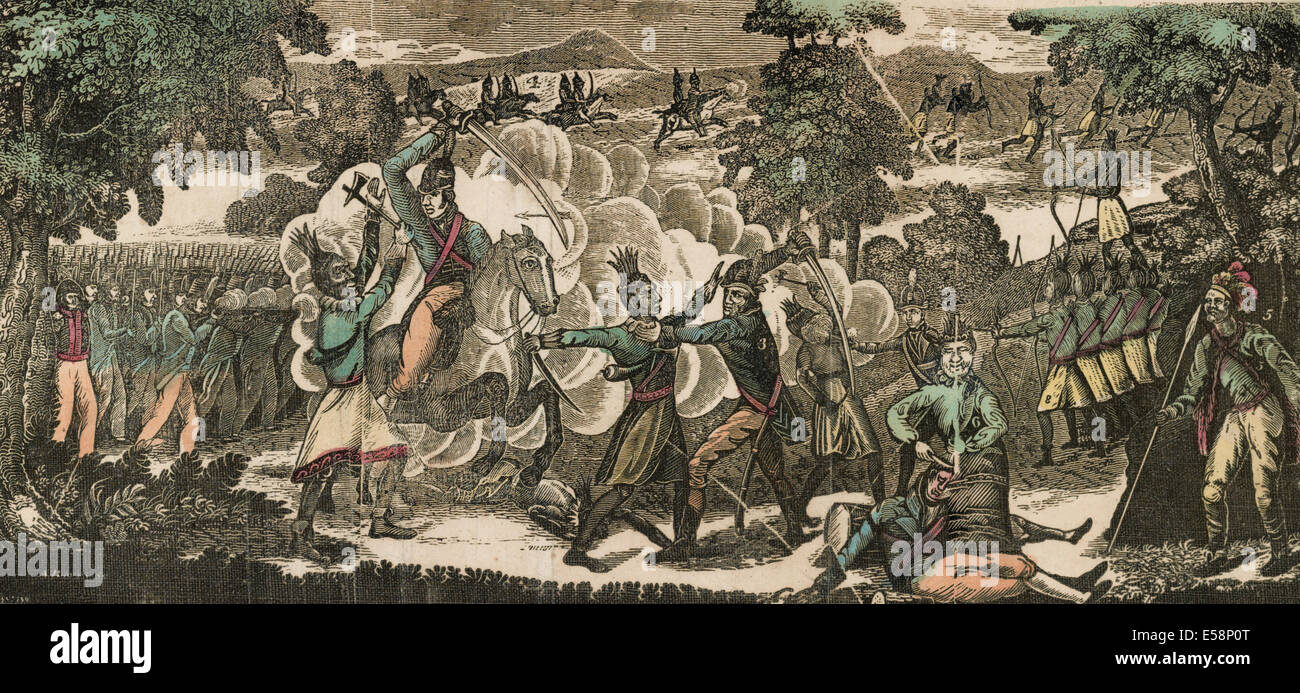 A view of Colonel Johnson's engagement with the Indians (commanded by Tecumseh) near Moravian Town, October 5th 1813 - battle between American forces under the command of Colonel Richard M. Johnson and Natives allied with the British under the command of Tecumseh. At center is detailed action with Johnson on horseback engaged with a Native wielding a tomahawk, a soldier fighting a Native, and a Native scalping a fallen soldier, with Tecumseh standing in the foreground. Stock Photohttps://www.alamy.com/image-license-details/?v=1https://www.alamy.com/stock-photo-a-view-of-colonel-johnsons-engagement-with-the-indians-commanded-by-72107640.html
A view of Colonel Johnson's engagement with the Indians (commanded by Tecumseh) near Moravian Town, October 5th 1813 - battle between American forces under the command of Colonel Richard M. Johnson and Natives allied with the British under the command of Tecumseh. At center is detailed action with Johnson on horseback engaged with a Native wielding a tomahawk, a soldier fighting a Native, and a Native scalping a fallen soldier, with Tecumseh standing in the foreground. Stock Photohttps://www.alamy.com/image-license-details/?v=1https://www.alamy.com/stock-photo-a-view-of-colonel-johnsons-engagement-with-the-indians-commanded-by-72107640.htmlRME58P0T–A view of Colonel Johnson's engagement with the Indians (commanded by Tecumseh) near Moravian Town, October 5th 1813 - battle between American forces under the command of Colonel Richard M. Johnson and Natives allied with the British under the command of Tecumseh. At center is detailed action with Johnson on horseback engaged with a Native wielding a tomahawk, a soldier fighting a Native, and a Native scalping a fallen soldier, with Tecumseh standing in the foreground.
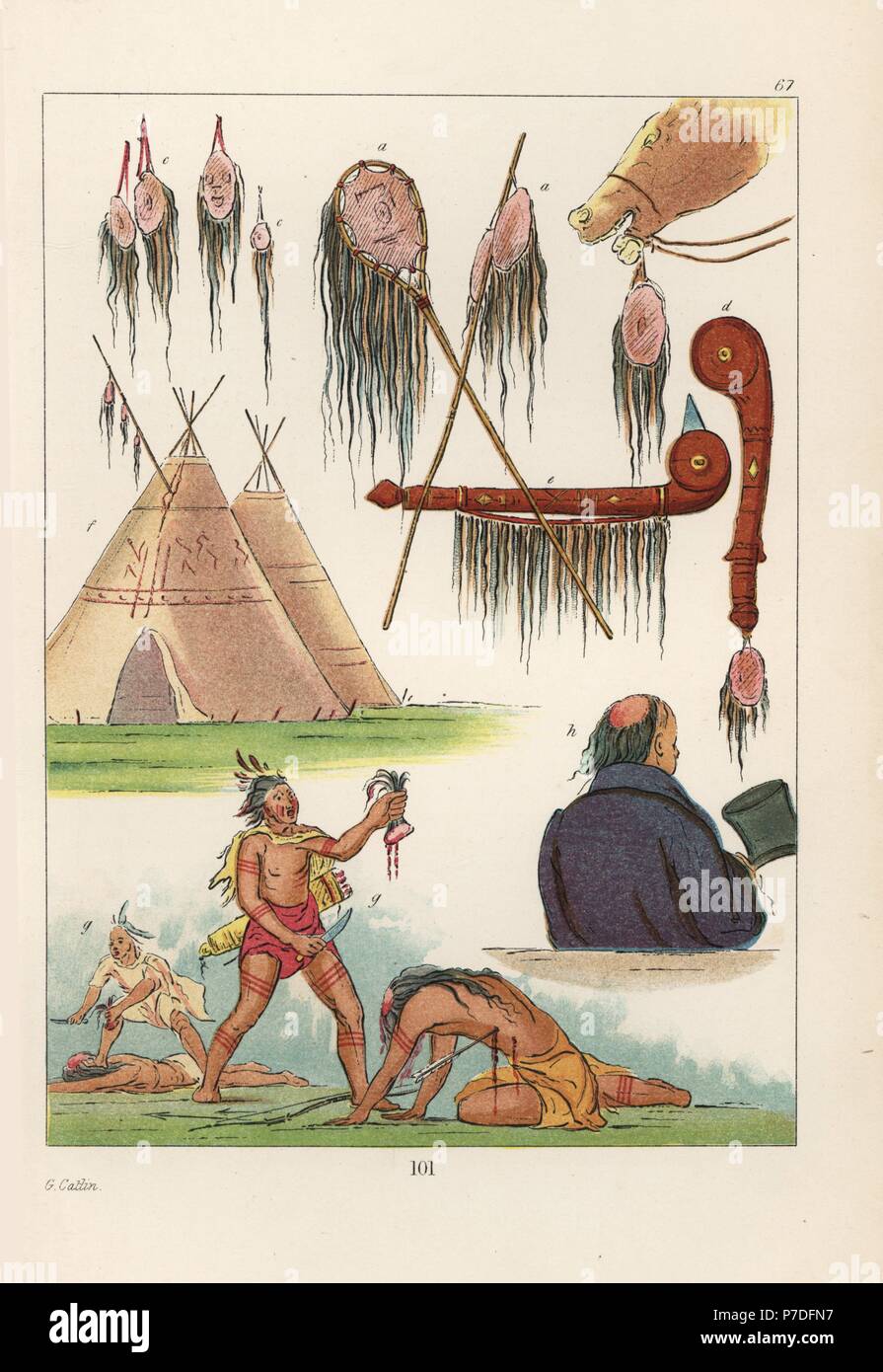 The practice of scalping a defeated enemy corpse by the Native Americans g, stretched scalps for a scalp dance a, small scalps c, scalp on a war club d, scalp pole on a teepee f and trophy on a bridle b. Man who has survived a scalping h. Handcoloured lithograph from George Catlin's Manners, Customs and Condition of the North American Indians, London, 1841. Stock Photohttps://www.alamy.com/image-license-details/?v=1https://www.alamy.com/the-practice-of-scalping-a-defeated-enemy-corpse-by-the-native-americans-g-stretched-scalps-for-a-scalp-dance-a-small-scalps-c-scalp-on-a-war-club-d-scalp-pole-on-a-teepee-f-and-trophy-on-a-bridle-b-man-who-has-survived-a-scalping-h-handcoloured-lithograph-from-george-catlins-manners-customs-and-condition-of-the-north-american-indians-london-1841-image211124739.html
The practice of scalping a defeated enemy corpse by the Native Americans g, stretched scalps for a scalp dance a, small scalps c, scalp on a war club d, scalp pole on a teepee f and trophy on a bridle b. Man who has survived a scalping h. Handcoloured lithograph from George Catlin's Manners, Customs and Condition of the North American Indians, London, 1841. Stock Photohttps://www.alamy.com/image-license-details/?v=1https://www.alamy.com/the-practice-of-scalping-a-defeated-enemy-corpse-by-the-native-americans-g-stretched-scalps-for-a-scalp-dance-a-small-scalps-c-scalp-on-a-war-club-d-scalp-pole-on-a-teepee-f-and-trophy-on-a-bridle-b-man-who-has-survived-a-scalping-h-handcoloured-lithograph-from-george-catlins-manners-customs-and-condition-of-the-north-american-indians-london-1841-image211124739.htmlRMP7DFN7–The practice of scalping a defeated enemy corpse by the Native Americans g, stretched scalps for a scalp dance a, small scalps c, scalp on a war club d, scalp pole on a teepee f and trophy on a bridle b. Man who has survived a scalping h. Handcoloured lithograph from George Catlin's Manners, Customs and Condition of the North American Indians, London, 1841.
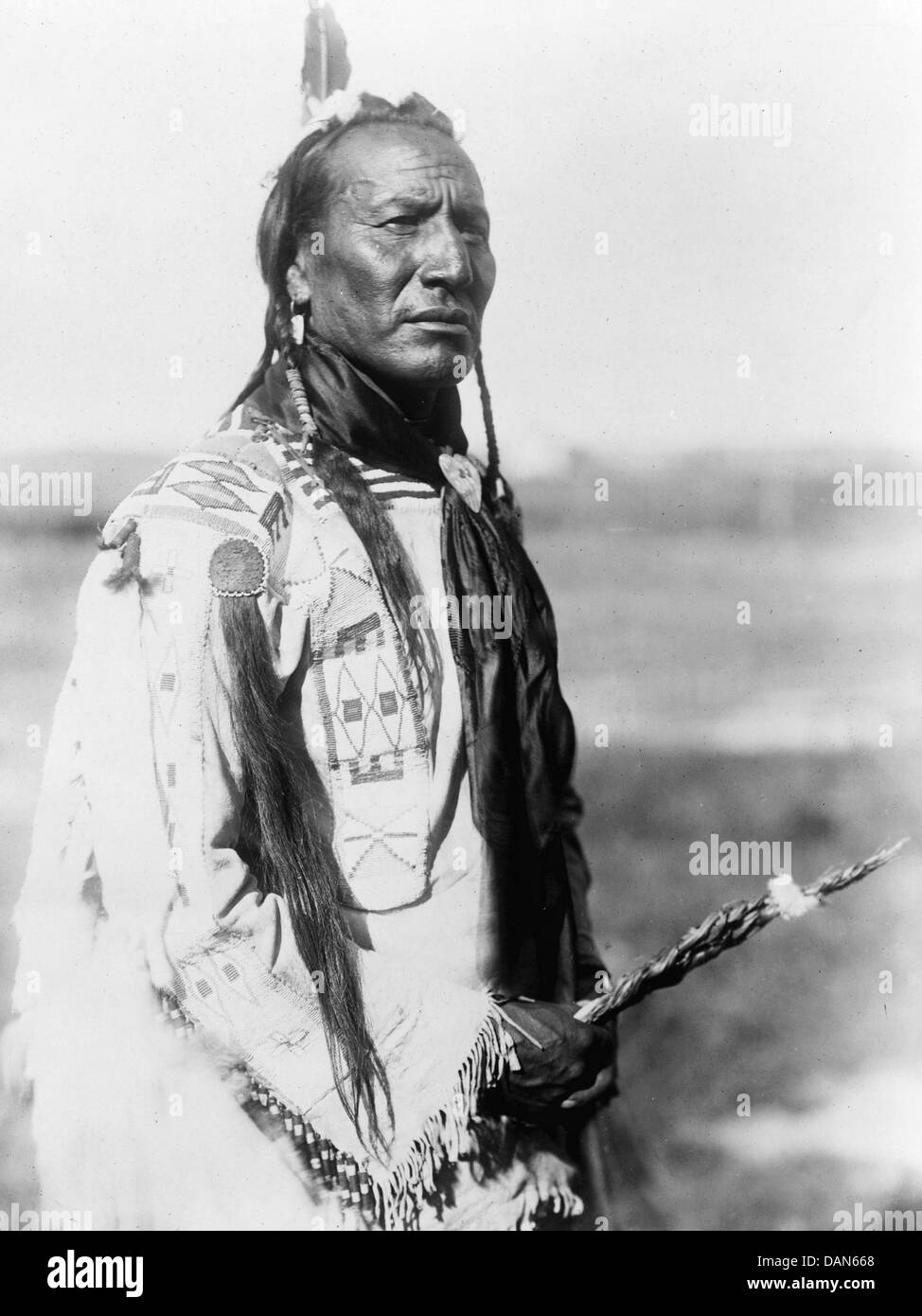 SCALPING Big Mouth Spring with a decorated scalping patch on his right shoulder. Photographed in 1910 by Edward S. Curtis Stock Photohttps://www.alamy.com/image-license-details/?v=1https://www.alamy.com/stock-photo-scalping-big-mouth-spring-with-a-decorated-scalping-patch-on-his-right-58243536.html
SCALPING Big Mouth Spring with a decorated scalping patch on his right shoulder. Photographed in 1910 by Edward S. Curtis Stock Photohttps://www.alamy.com/image-license-details/?v=1https://www.alamy.com/stock-photo-scalping-big-mouth-spring-with-a-decorated-scalping-patch-on-his-right-58243536.htmlRMDAN668–SCALPING Big Mouth Spring with a decorated scalping patch on his right shoulder. Photographed in 1910 by Edward S. Curtis
 Native American scalping a soldier after killing him Stock Photohttps://www.alamy.com/image-license-details/?v=1https://www.alamy.com/stock-photo-native-american-scalping-a-soldier-after-killing-him-105255602.html
Native American scalping a soldier after killing him Stock Photohttps://www.alamy.com/image-license-details/?v=1https://www.alamy.com/stock-photo-native-american-scalping-a-soldier-after-killing-him-105255602.htmlRMG36PGJ–Native American scalping a soldier after killing him
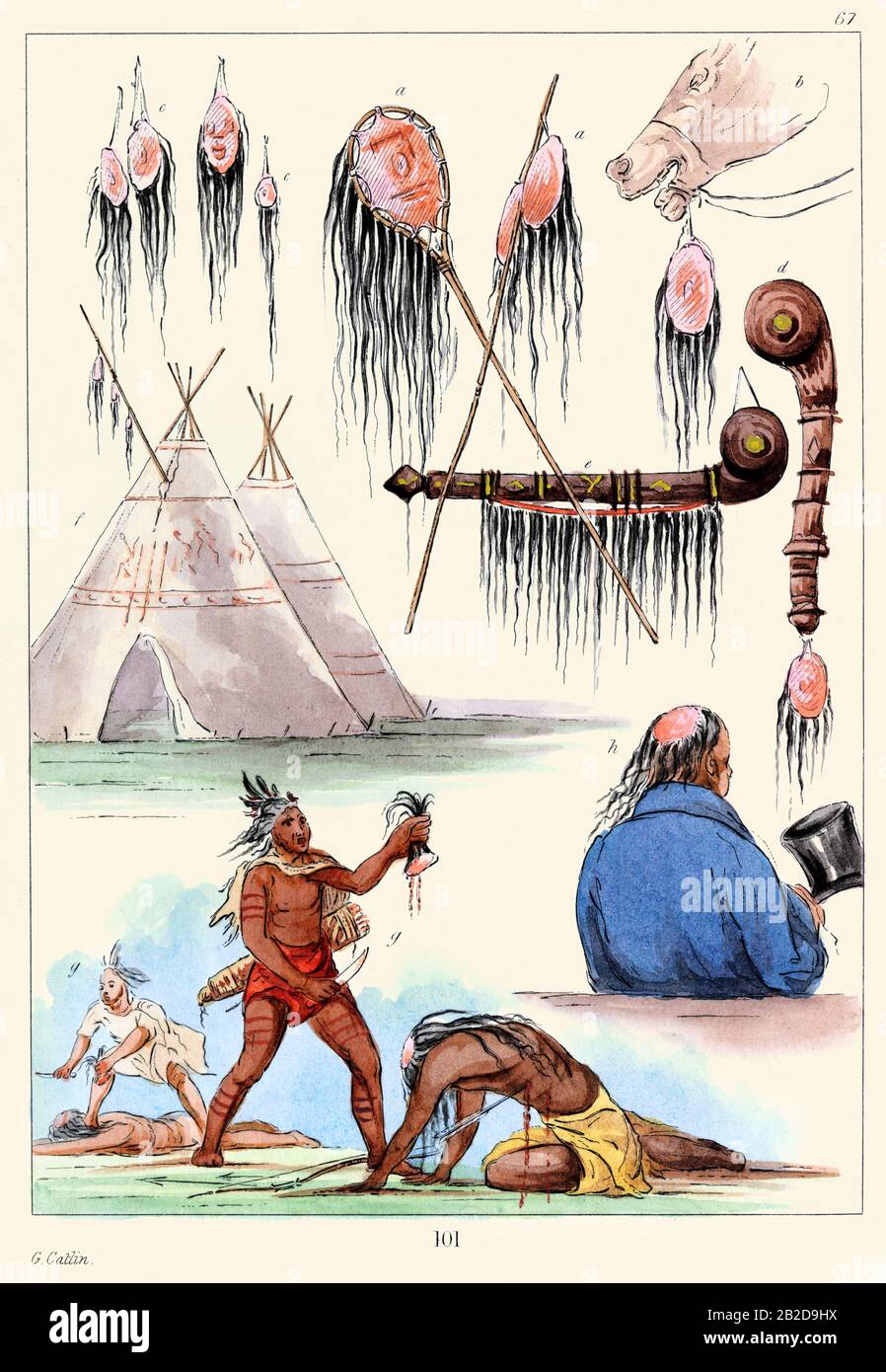 Scalps and scalping Stock Photohttps://www.alamy.com/image-license-details/?v=1https://www.alamy.com/scalps-and-scalping-image345729606.html
Scalps and scalping Stock Photohttps://www.alamy.com/image-license-details/?v=1https://www.alamy.com/scalps-and-scalping-image345729606.htmlRM2B2D9HX–Scalps and scalping
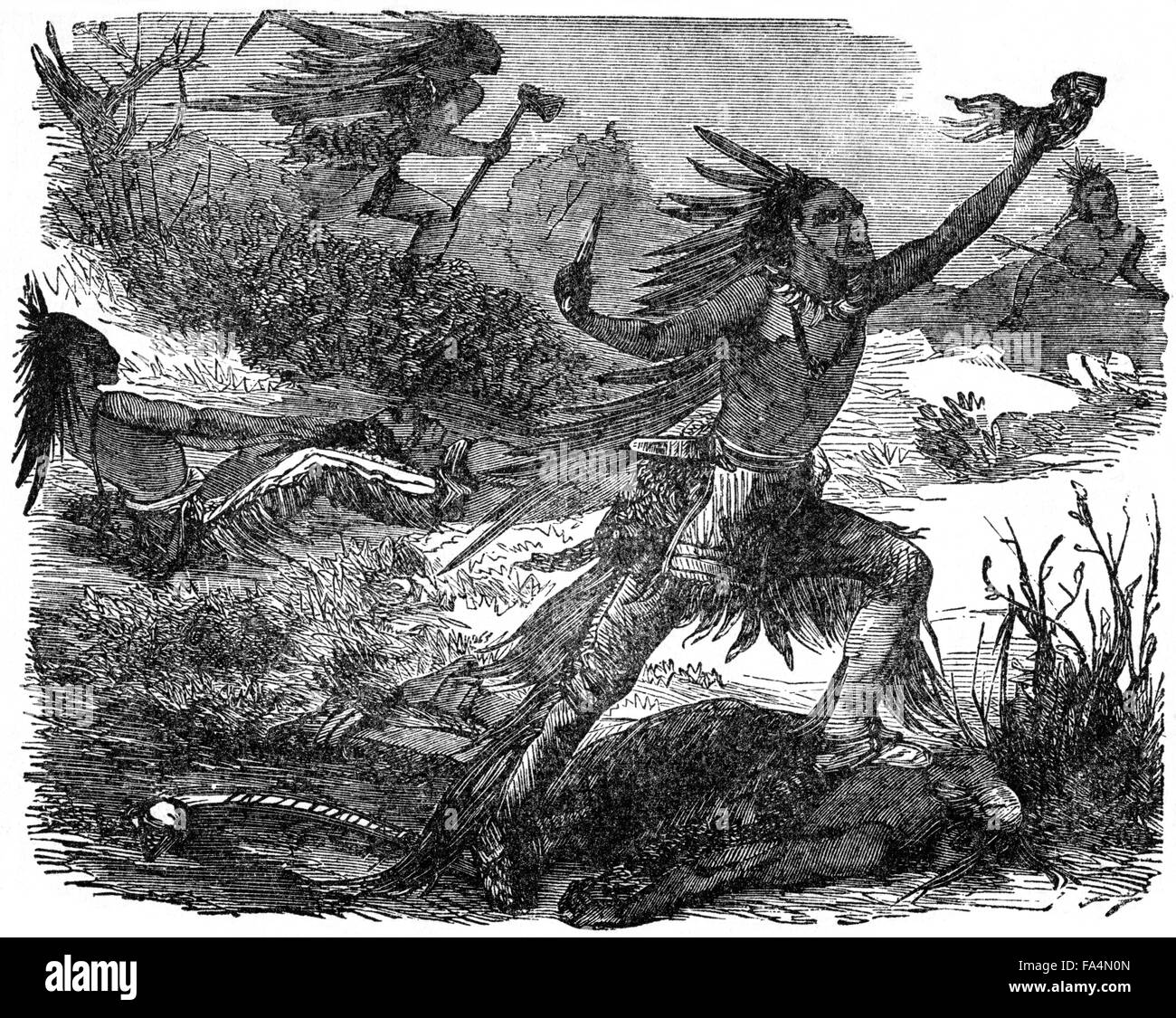 “Indians Scalping Their Victims”, Book Illustration from “Indian Horrors or Massacres of the Red Men”, by Henry Davenport Northrop, 1891 Stock Photohttps://www.alamy.com/image-license-details/?v=1https://www.alamy.com/stock-photo-indians-scalping-their-victims-book-illustration-from-indian-horrors-92302693.html
“Indians Scalping Their Victims”, Book Illustration from “Indian Horrors or Massacres of the Red Men”, by Henry Davenport Northrop, 1891 Stock Photohttps://www.alamy.com/image-license-details/?v=1https://www.alamy.com/stock-photo-indians-scalping-their-victims-book-illustration-from-indian-horrors-92302693.htmlRMFA4N0N–“Indians Scalping Their Victims”, Book Illustration from “Indian Horrors or Massacres of the Red Men”, by Henry Davenport Northrop, 1891
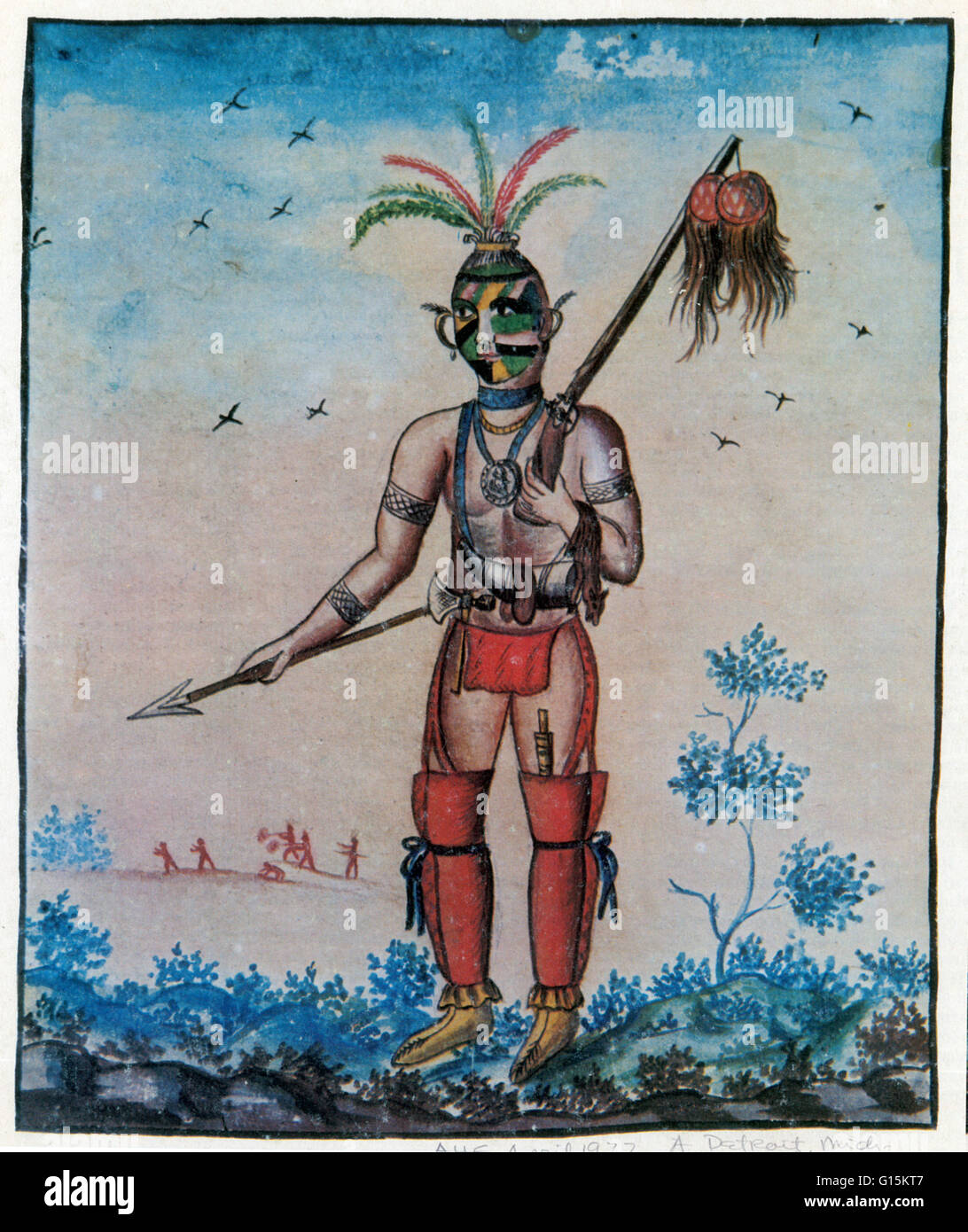 A mid-18th century painting by an unknown French artist of a Native American man with scalps in the area that is now Detroit, Michigan. During the French and Indian War, French colonists offered payments to Native Americans for British scalps. Stock Photohttps://www.alamy.com/image-license-details/?v=1https://www.alamy.com/stock-photo-a-mid-18th-century-painting-by-an-unknown-french-artist-of-a-native-104002199.html
A mid-18th century painting by an unknown French artist of a Native American man with scalps in the area that is now Detroit, Michigan. During the French and Indian War, French colonists offered payments to Native Americans for British scalps. Stock Photohttps://www.alamy.com/image-license-details/?v=1https://www.alamy.com/stock-photo-a-mid-18th-century-painting-by-an-unknown-french-artist-of-a-native-104002199.htmlRMG15KT7–A mid-18th century painting by an unknown French artist of a Native American man with scalps in the area that is now Detroit, Michigan. During the French and Indian War, French colonists offered payments to Native Americans for British scalps.
 A scene on the frontiers as practiced by the 'humane' British and their 'worthy' allies. by William Charles,1776-1820, artist 1812. print on wove paper;etching with watercolour. Charles denounces British and Indian depredations on the American frontier during the War of 1812, alluding specifically to the practice of offering bounties for American scalps. Stock Photohttps://www.alamy.com/image-license-details/?v=1https://www.alamy.com/a-scene-on-the-frontiers-as-practiced-by-the-humane-british-and-their-worthy-allies-by-william-charles1776-1820-artist-1812-print-on-wove-paperetching-with-watercolour-charles-denounces-british-and-indian-depredations-on-the-american-frontier-during-the-war-of-1812-alluding-specifically-to-the-practice-of-offering-bounties-for-american-scalps-image230631273.html
A scene on the frontiers as practiced by the 'humane' British and their 'worthy' allies. by William Charles,1776-1820, artist 1812. print on wove paper;etching with watercolour. Charles denounces British and Indian depredations on the American frontier during the War of 1812, alluding specifically to the practice of offering bounties for American scalps. Stock Photohttps://www.alamy.com/image-license-details/?v=1https://www.alamy.com/a-scene-on-the-frontiers-as-practiced-by-the-humane-british-and-their-worthy-allies-by-william-charles1776-1820-artist-1812-print-on-wove-paperetching-with-watercolour-charles-denounces-british-and-indian-depredations-on-the-american-frontier-during-the-war-of-1812-alluding-specifically-to-the-practice-of-offering-bounties-for-american-scalps-image230631273.htmlRMRB64F5–A scene on the frontiers as practiced by the 'humane' British and their 'worthy' allies. by William Charles,1776-1820, artist 1812. print on wove paper;etching with watercolour. Charles denounces British and Indian depredations on the American frontier during the War of 1812, alluding specifically to the practice of offering bounties for American scalps.
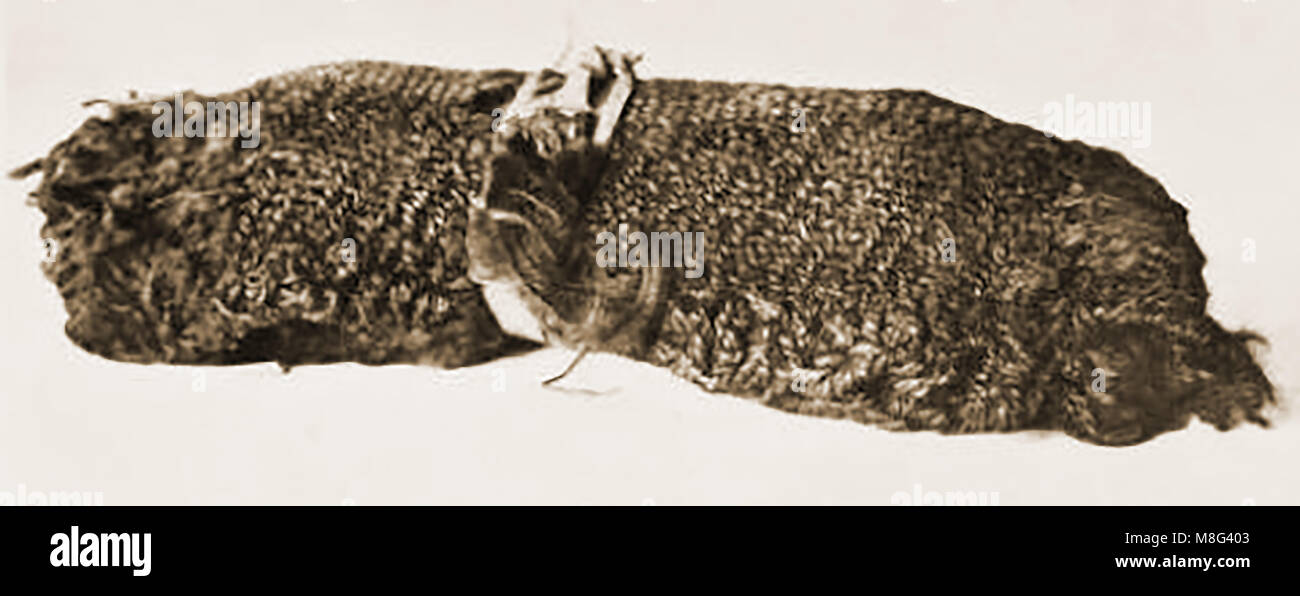 An early Native American Indian 'sacred bundle'sacred or 'medicine bundle' belonging to the Osage Indians -Contains such items as human scalps, eagle feathers, buffalo bladders and pipes. Stock Photohttps://www.alamy.com/image-license-details/?v=1https://www.alamy.com/stock-photo-an-early-native-american-indian-sacred-bundlesacred-or-medicine-bundle-177375299.html
An early Native American Indian 'sacred bundle'sacred or 'medicine bundle' belonging to the Osage Indians -Contains such items as human scalps, eagle feathers, buffalo bladders and pipes. Stock Photohttps://www.alamy.com/image-license-details/?v=1https://www.alamy.com/stock-photo-an-early-native-american-indian-sacred-bundlesacred-or-medicine-bundle-177375299.htmlRMM8G403–An early Native American Indian 'sacred bundle'sacred or 'medicine bundle' belonging to the Osage Indians -Contains such items as human scalps, eagle feathers, buffalo bladders and pipes.
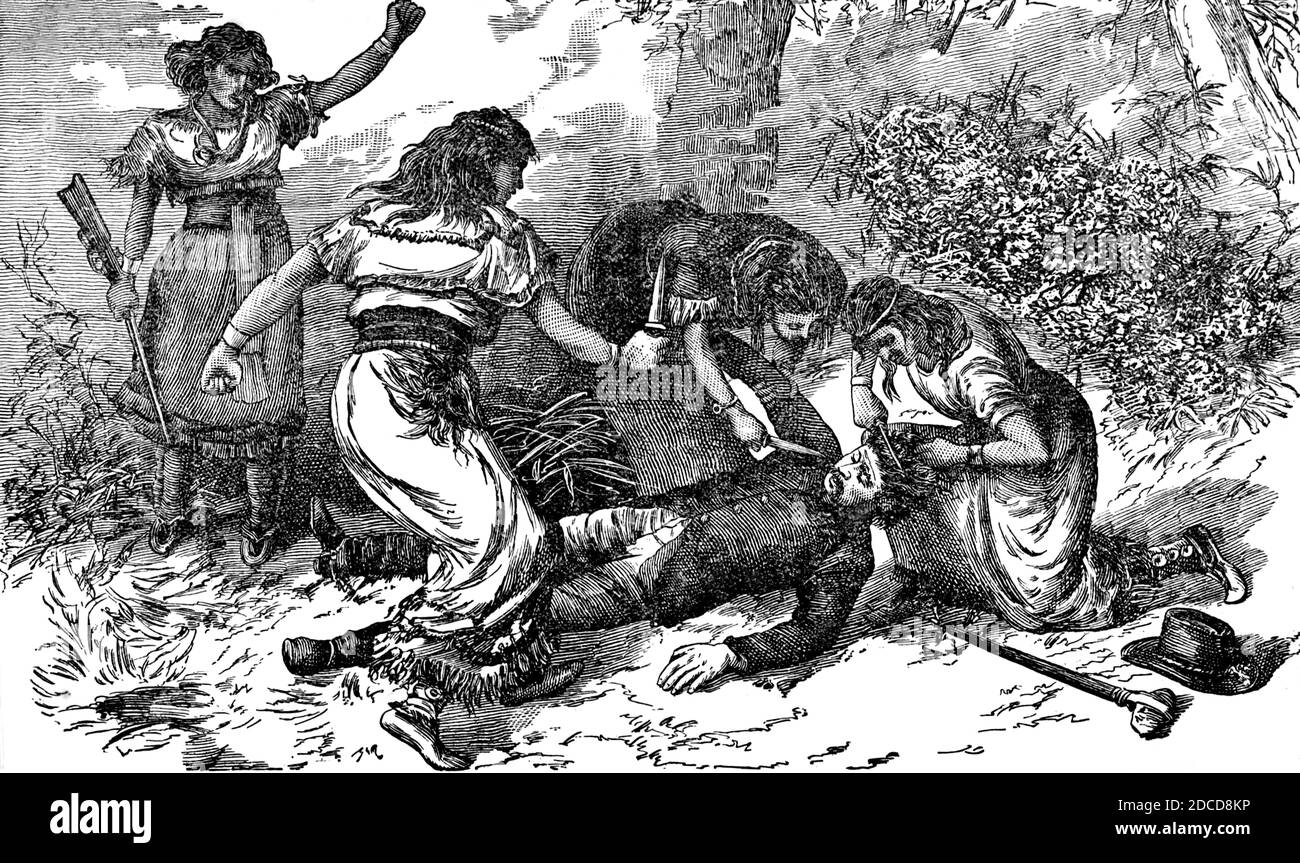 Native Americans Scalping Pioneer, 18th Century Stock Photohttps://www.alamy.com/image-license-details/?v=1https://www.alamy.com/native-americans-scalping-pioneer-18th-century-image386296170.html
Native Americans Scalping Pioneer, 18th Century Stock Photohttps://www.alamy.com/image-license-details/?v=1https://www.alamy.com/native-americans-scalping-pioneer-18th-century-image386296170.htmlRF2DCD8KP–Native Americans Scalping Pioneer, 18th Century
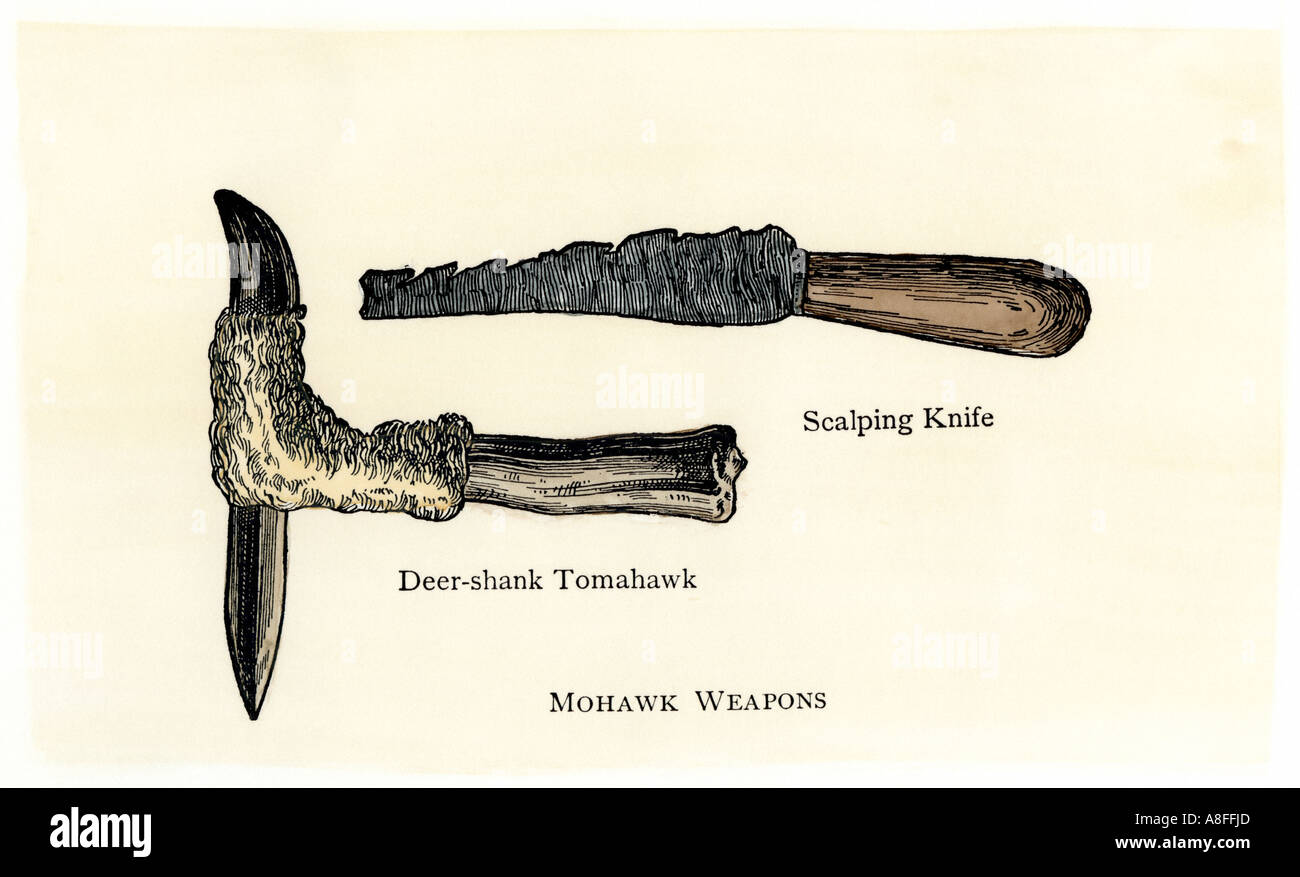 Mohawk tomahawk made from a deer shank bone and a scalping knife. Hand-colored woodcut Stock Photohttps://www.alamy.com/image-license-details/?v=1https://www.alamy.com/mohawk-tomahawk-made-from-a-deer-shank-bone-and-a-scalping-knife-hand-image6907500.html
Mohawk tomahawk made from a deer shank bone and a scalping knife. Hand-colored woodcut Stock Photohttps://www.alamy.com/image-license-details/?v=1https://www.alamy.com/mohawk-tomahawk-made-from-a-deer-shank-bone-and-a-scalping-knife-hand-image6907500.htmlRMA8FFJD–Mohawk tomahawk made from a deer shank bone and a scalping knife. Hand-colored woodcut
 A Scene on the Frontiers Stock Photohttps://www.alamy.com/image-license-details/?v=1https://www.alamy.com/a-scene-on-the-frontiers-image446708718.html
A Scene on the Frontiers Stock Photohttps://www.alamy.com/image-license-details/?v=1https://www.alamy.com/a-scene-on-the-frontiers-image446708718.htmlRM2GXN9EP–A Scene on the Frontiers
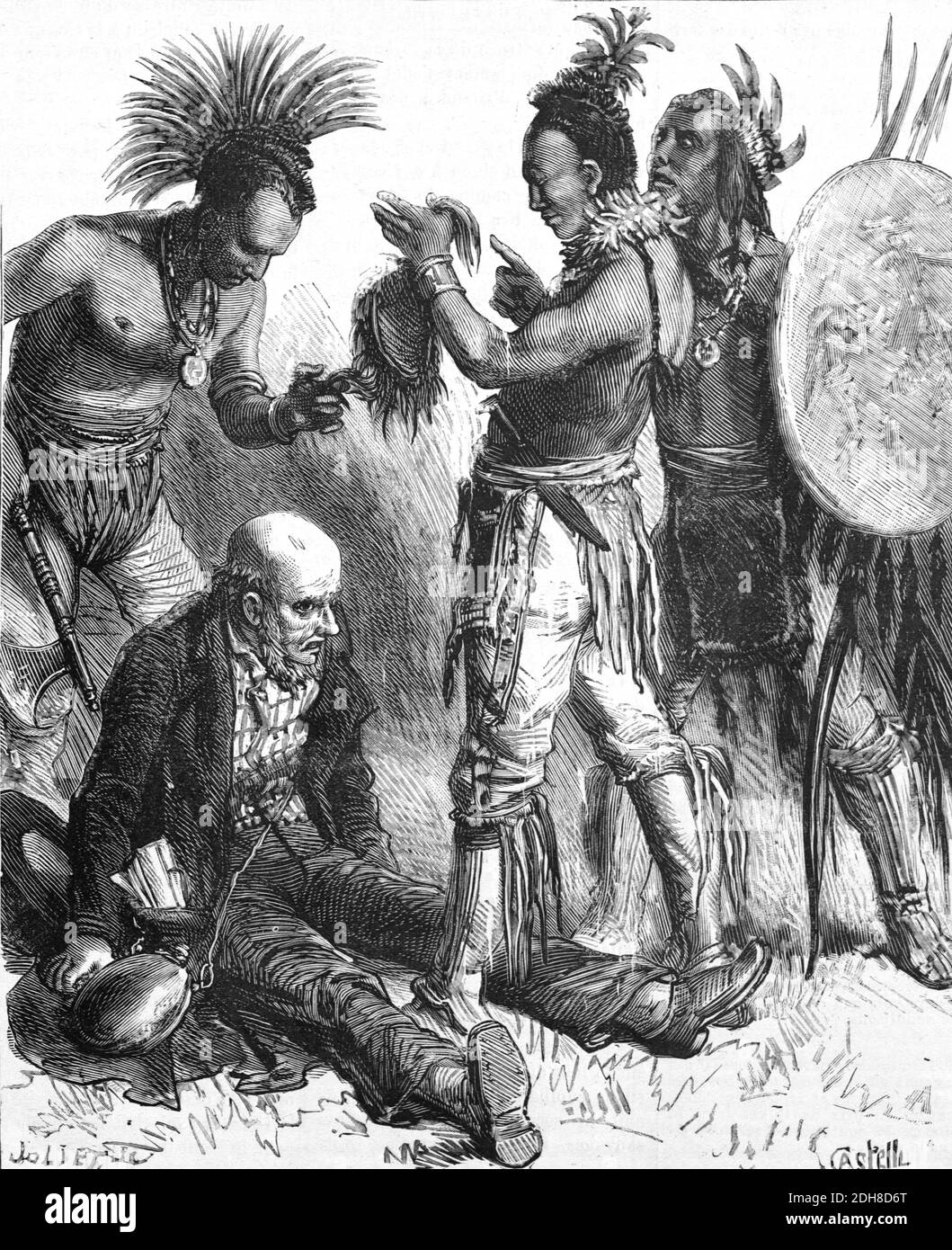 Native Americans, First Nation People or American Indians Scalping European Settler or Surprised by Wig Worn by Bald Man (Engr 1880 Castelli) Vintage Illustration or Engraving Stock Photohttps://www.alamy.com/image-license-details/?v=1https://www.alamy.com/native-americans-first-nation-people-or-american-indians-scalping-european-settler-or-surprised-by-wig-worn-by-bald-man-engr-1880-castelli-vintage-illustration-or-engraving-image389263248.html
Native Americans, First Nation People or American Indians Scalping European Settler or Surprised by Wig Worn by Bald Man (Engr 1880 Castelli) Vintage Illustration or Engraving Stock Photohttps://www.alamy.com/image-license-details/?v=1https://www.alamy.com/native-americans-first-nation-people-or-american-indians-scalping-european-settler-or-surprised-by-wig-worn-by-bald-man-engr-1880-castelli-vintage-illustration-or-engraving-image389263248.htmlRM2DH8D6T–Native Americans, First Nation People or American Indians Scalping European Settler or Surprised by Wig Worn by Bald Man (Engr 1880 Castelli) Vintage Illustration or Engraving
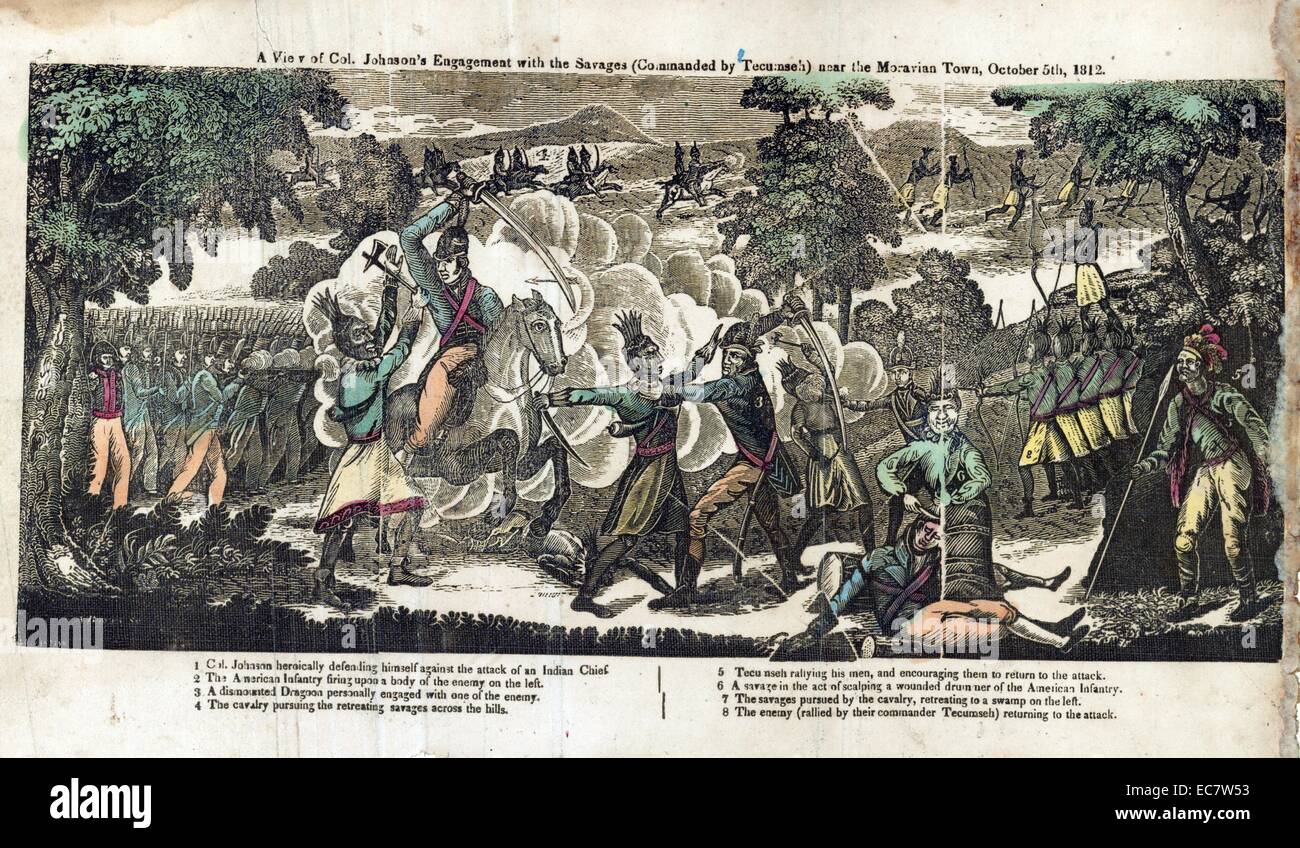 Woodcut print shows the battle between American forces under the command of Colonel Richard M. Johnson and Natives allied with the British under the command of Tecumseh. At center is detailed action with Johnson on horseback engaged with a Native wielding a tomahawk, a soldier fighting a Native, and a Native scalping a fallen soldier, with Tecumseh standing in the foreground, on the far right. 1750-1850 Stock Photohttps://www.alamy.com/image-license-details/?v=1https://www.alamy.com/stock-photo-woodcut-print-shows-the-battle-between-american-forces-under-the-command-76390751.html
Woodcut print shows the battle between American forces under the command of Colonel Richard M. Johnson and Natives allied with the British under the command of Tecumseh. At center is detailed action with Johnson on horseback engaged with a Native wielding a tomahawk, a soldier fighting a Native, and a Native scalping a fallen soldier, with Tecumseh standing in the foreground, on the far right. 1750-1850 Stock Photohttps://www.alamy.com/image-license-details/?v=1https://www.alamy.com/stock-photo-woodcut-print-shows-the-battle-between-american-forces-under-the-command-76390751.htmlRMEC7W53–Woodcut print shows the battle between American forces under the command of Colonel Richard M. Johnson and Natives allied with the British under the command of Tecumseh. At center is detailed action with Johnson on horseback engaged with a Native wielding a tomahawk, a soldier fighting a Native, and a Native scalping a fallen soldier, with Tecumseh standing in the foreground, on the far right. 1750-1850
 The death cry - An American Indian scalps a settler Stock Photohttps://www.alamy.com/image-license-details/?v=1https://www.alamy.com/stock-photo-the-death-cry-an-american-indian-scalps-a-settler-31647135.html
The death cry - An American Indian scalps a settler Stock Photohttps://www.alamy.com/image-license-details/?v=1https://www.alamy.com/stock-photo-the-death-cry-an-american-indian-scalps-a-settler-31647135.htmlRMBRDJ6R–The death cry - An American Indian scalps a settler
 Racial Scalping C1850 Stock Photohttps://www.alamy.com/image-license-details/?v=1https://www.alamy.com/racial-scalping-c1850-image5072413.html
Racial Scalping C1850 Stock Photohttps://www.alamy.com/image-license-details/?v=1https://www.alamy.com/racial-scalping-c1850-image5072413.htmlRMANHX1E–Racial Scalping C1850
 “Scalp Dance of the Comanches”, Book Illustration from “Indian Horrors or Massacres of the Red Men”, by Henry Davenport Northrop, 1891 Stock Photohttps://www.alamy.com/image-license-details/?v=1https://www.alamy.com/stock-photo-scalp-dance-of-the-comanches-book-illustration-from-indian-horrors-92302704.html
“Scalp Dance of the Comanches”, Book Illustration from “Indian Horrors or Massacres of the Red Men”, by Henry Davenport Northrop, 1891 Stock Photohttps://www.alamy.com/image-license-details/?v=1https://www.alamy.com/stock-photo-scalp-dance-of-the-comanches-book-illustration-from-indian-horrors-92302704.htmlRMFA4N14–“Scalp Dance of the Comanches”, Book Illustration from “Indian Horrors or Massacres of the Red Men”, by Henry Davenport Northrop, 1891
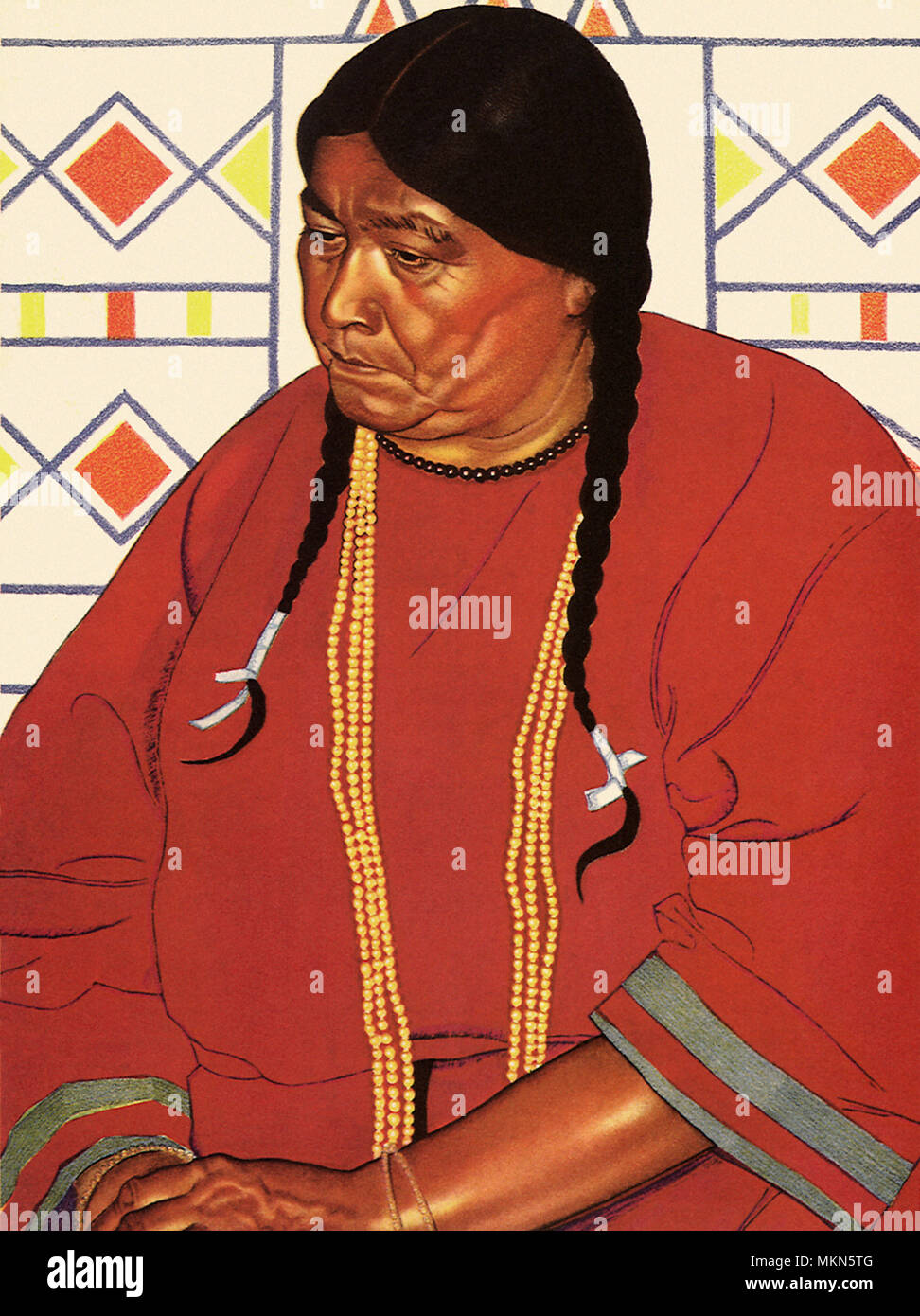 Scalping Woman Stock Photohttps://www.alamy.com/image-license-details/?v=1https://www.alamy.com/scalping-woman-image184247744.html
Scalping Woman Stock Photohttps://www.alamy.com/image-license-details/?v=1https://www.alamy.com/scalping-woman-image184247744.htmlRMMKN5TG–Scalping Woman
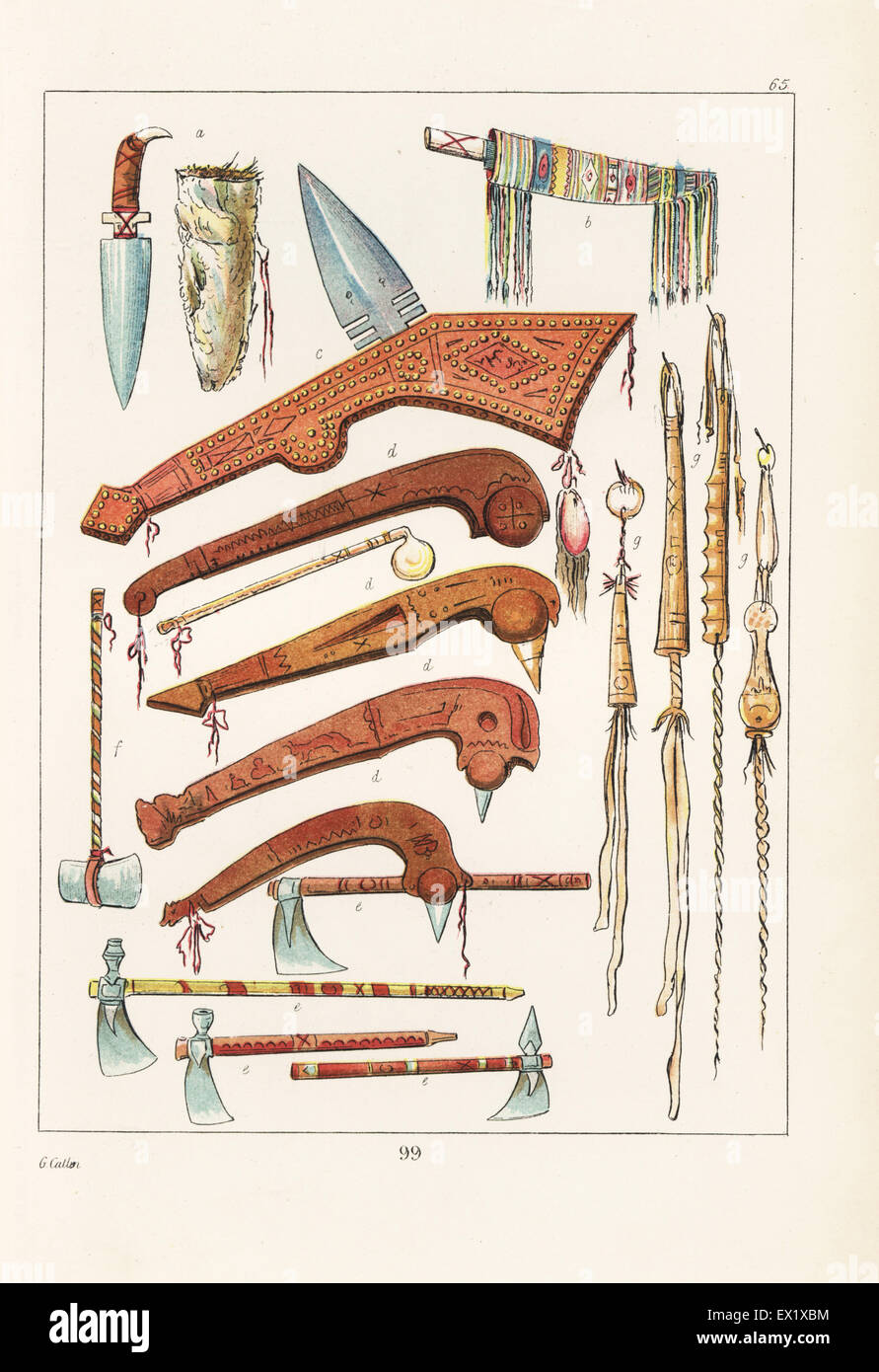 Weapons of the Native Americans: scalping knives and scabbards a,b, war clubs c, clubs d tomahawks and pipe tomahawks e, hatchet f and horse whips g. Handcoloured lithograph from George Catlin's Manners, Customs and Condition of the North American Indians, London, 1841. Stock Photohttps://www.alamy.com/image-license-details/?v=1https://www.alamy.com/stock-photo-weapons-of-the-native-americans-scalping-knives-and-scabbards-ab-war-84865192.html
Weapons of the Native Americans: scalping knives and scabbards a,b, war clubs c, clubs d tomahawks and pipe tomahawks e, hatchet f and horse whips g. Handcoloured lithograph from George Catlin's Manners, Customs and Condition of the North American Indians, London, 1841. Stock Photohttps://www.alamy.com/image-license-details/?v=1https://www.alamy.com/stock-photo-weapons-of-the-native-americans-scalping-knives-and-scabbards-ab-war-84865192.htmlRMEX1XBM–Weapons of the Native Americans: scalping knives and scabbards a,b, war clubs c, clubs d tomahawks and pipe tomahawks e, hatchet f and horse whips g. Handcoloured lithograph from George Catlin's Manners, Customs and Condition of the North American Indians, London, 1841.
 ROBBING AND SCALPING Stock Photohttps://www.alamy.com/image-license-details/?v=1https://www.alamy.com/stock-photo-robbing-and-scalping-56702796.html
ROBBING AND SCALPING Stock Photohttps://www.alamy.com/image-license-details/?v=1https://www.alamy.com/stock-photo-robbing-and-scalping-56702796.htmlRMD870YT–ROBBING AND SCALPING
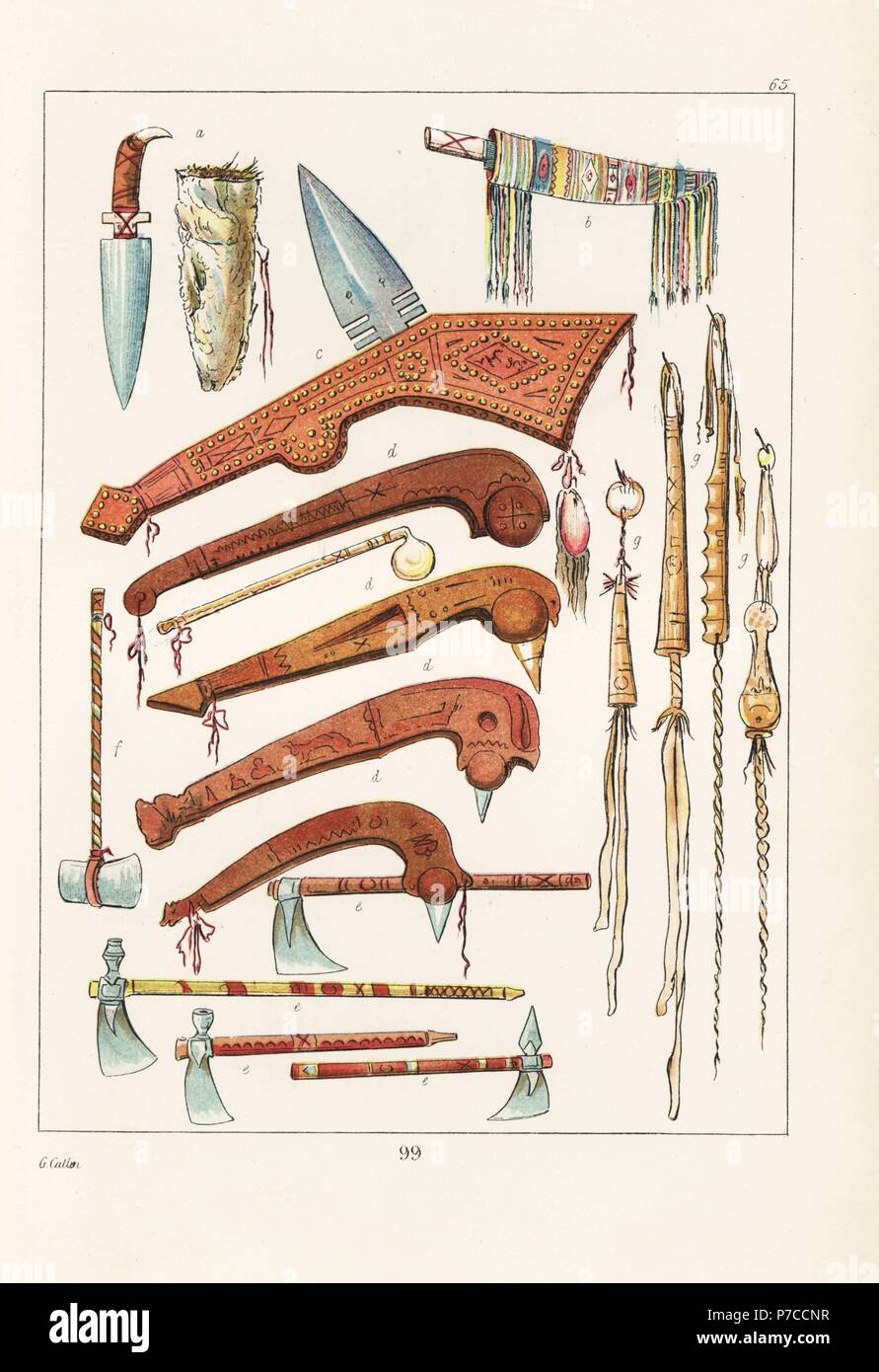 Weapons of the Native Americans: scalping knives and scabbards a,b, war clubs c, clubs d tomahawks and pipe tomahawks e, hatchet f and horse whips g. Handcoloured lithograph from George Catlin's Manners, Customs and Condition of the North American Indians, London, 1841. Stock Photohttps://www.alamy.com/image-license-details/?v=1https://www.alamy.com/weapons-of-the-native-americans-scalping-knives-and-scabbards-ab-war-clubs-c-clubs-d-tomahawks-and-pipe-tomahawks-e-hatchet-f-and-horse-whips-g-handcoloured-lithograph-from-george-catlins-manners-customs-and-condition-of-the-north-american-indians-london-1841-image211100451.html
Weapons of the Native Americans: scalping knives and scabbards a,b, war clubs c, clubs d tomahawks and pipe tomahawks e, hatchet f and horse whips g. Handcoloured lithograph from George Catlin's Manners, Customs and Condition of the North American Indians, London, 1841. Stock Photohttps://www.alamy.com/image-license-details/?v=1https://www.alamy.com/weapons-of-the-native-americans-scalping-knives-and-scabbards-ab-war-clubs-c-clubs-d-tomahawks-and-pipe-tomahawks-e-hatchet-f-and-horse-whips-g-handcoloured-lithograph-from-george-catlins-manners-customs-and-condition-of-the-north-american-indians-london-1841-image211100451.htmlRMP7CCNR–Weapons of the Native Americans: scalping knives and scabbards a,b, war clubs c, clubs d tomahawks and pipe tomahawks e, hatchet f and horse whips g. Handcoloured lithograph from George Catlin's Manners, Customs and Condition of the North American Indians, London, 1841.
 Native Americans scalping their enemy. Engraving by unknown artist from Ernst von Hesse-Warteggs Nord Amerika, swedish edition published in 1880 Stock Photohttps://www.alamy.com/image-license-details/?v=1https://www.alamy.com/native-americans-scalping-their-enemy-engraving-by-unknown-artist-from-ernst-von-hesse-warteggs-nord-amerika-swedish-edition-published-in-1880-image566412286.html
Native Americans scalping their enemy. Engraving by unknown artist from Ernst von Hesse-Warteggs Nord Amerika, swedish edition published in 1880 Stock Photohttps://www.alamy.com/image-license-details/?v=1https://www.alamy.com/native-americans-scalping-their-enemy-engraving-by-unknown-artist-from-ernst-von-hesse-warteggs-nord-amerika-swedish-edition-published-in-1880-image566412286.htmlRF2RWE8J6–Native Americans scalping their enemy. Engraving by unknown artist from Ernst von Hesse-Warteggs Nord Amerika, swedish edition published in 1880
 Indian Utensils 1. Shield and lance. 2. Wampum. 3. War-club. 4. Hammer, antique. 5. Pipe head. 6. Rawhide double ball, used in game like hockey. 7. Snowshoe 8. Pottery. 9. Scalping knife and sheath. 10. Knapsack. From the book ' The song of Hiawatha ' by Longfellow, Henry Wadsworth, 1807-1882 Published by Mifflin and Company in 1898 Stock Photohttps://www.alamy.com/image-license-details/?v=1https://www.alamy.com/indian-utensils-1-shield-and-lance-2-wampum-3-war-club-4-hammer-antique-5-pipe-head-6-rawhide-double-ball-used-in-game-like-hockey-7-snowshoe-8-pottery-9-scalping-knife-and-sheath-10-knapsack-from-the-book-the-song-of-hiawatha-by-longfellow-henry-wadsworth-1807-1882-published-by-mifflin-and-company-in-1898-image561295018.html
Indian Utensils 1. Shield and lance. 2. Wampum. 3. War-club. 4. Hammer, antique. 5. Pipe head. 6. Rawhide double ball, used in game like hockey. 7. Snowshoe 8. Pottery. 9. Scalping knife and sheath. 10. Knapsack. From the book ' The song of Hiawatha ' by Longfellow, Henry Wadsworth, 1807-1882 Published by Mifflin and Company in 1898 Stock Photohttps://www.alamy.com/image-license-details/?v=1https://www.alamy.com/indian-utensils-1-shield-and-lance-2-wampum-3-war-club-4-hammer-antique-5-pipe-head-6-rawhide-double-ball-used-in-game-like-hockey-7-snowshoe-8-pottery-9-scalping-knife-and-sheath-10-knapsack-from-the-book-the-song-of-hiawatha-by-longfellow-henry-wadsworth-1807-1882-published-by-mifflin-and-company-in-1898-image561295018.htmlRF2RH55EJ–Indian Utensils 1. Shield and lance. 2. Wampum. 3. War-club. 4. Hammer, antique. 5. Pipe head. 6. Rawhide double ball, used in game like hockey. 7. Snowshoe 8. Pottery. 9. Scalping knife and sheath. 10. Knapsack. From the book ' The song of Hiawatha ' by Longfellow, Henry Wadsworth, 1807-1882 Published by Mifflin and Company in 1898
 Scalping the death victim Stock Photohttps://www.alamy.com/image-license-details/?v=1https://www.alamy.com/stock-photo-scalping-the-death-victim-20783097.html
Scalping the death victim Stock Photohttps://www.alamy.com/image-license-details/?v=1https://www.alamy.com/stock-photo-scalping-the-death-victim-20783097.htmlRMB5PN1D–Scalping the death victim
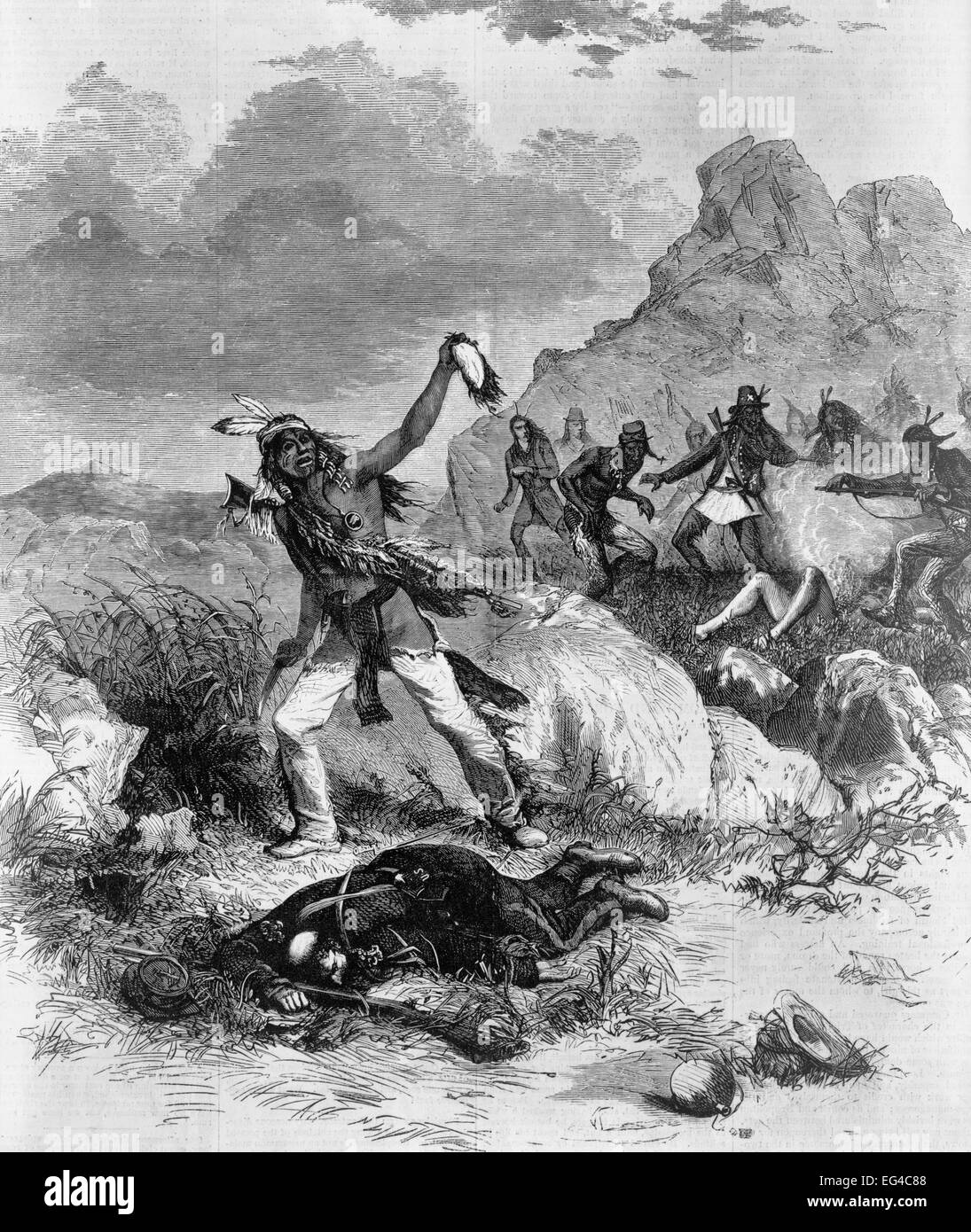 Modocs scalping and torturing prisoners - Illustration shows a Modoc Indian holding up the scalp of a dead soldier lying at his feet; in the background are other Modocs standing near the body of another soldier, circa 1873 Stock Photohttps://www.alamy.com/image-license-details/?v=1https://www.alamy.com/stock-photo-modocs-scalping-and-torturing-prisoners-illustration-shows-a-modoc-78773416.html
Modocs scalping and torturing prisoners - Illustration shows a Modoc Indian holding up the scalp of a dead soldier lying at his feet; in the background are other Modocs standing near the body of another soldier, circa 1873 Stock Photohttps://www.alamy.com/image-license-details/?v=1https://www.alamy.com/stock-photo-modocs-scalping-and-torturing-prisoners-illustration-shows-a-modoc-78773416.htmlRMEG4C88–Modocs scalping and torturing prisoners - Illustration shows a Modoc Indian holding up the scalp of a dead soldier lying at his feet; in the background are other Modocs standing near the body of another soldier, circa 1873
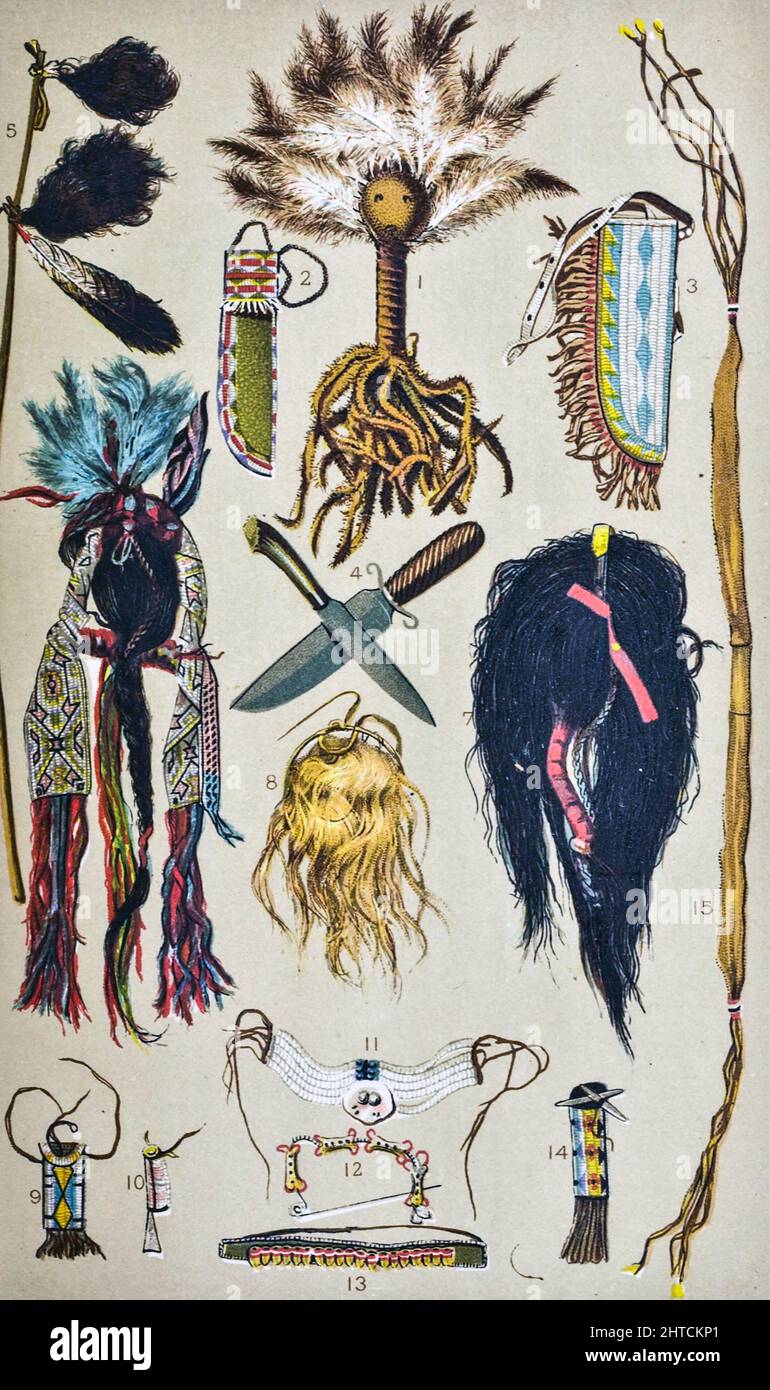 Objects of Interest and Curiosity: Scalps of Indians and White People. Ornaments made of Human Skin and Bones, &c. 1. Kiowa Medicine Rattle. 2. Sheath of Scalping Knife (Sioux). 3. Sheath of Scalping Knife (Cheyenne). 4. Scalping Knives. 5. Scalps of Two White Men, arranged on a Wand fob the Scalp Dance. 6. Scalp of a Sioux Indian. Elaborately ornamented with feathers and beads. 7. Scalp of a Sioux Indian, taken entire. 8. Scalp of a Little White Girl. This scalp was taken from the Comanches. The little girl was about nine years old. 9. Ute Match Safe, Beaded. 10. Ute Needle Case, Beaded. 11. Stock Photohttps://www.alamy.com/image-license-details/?v=1https://www.alamy.com/objects-of-interest-and-curiosity-scalps-of-indians-and-white-people-ornaments-made-of-human-skin-and-bones-c-1-kiowa-medicine-rattle-2-sheath-of-scalping-knife-sioux-3-sheath-of-scalping-knife-cheyenne-4-scalping-knives-5-scalps-of-two-white-men-arranged-on-a-wand-fob-the-scalp-dance-6-scalp-of-a-sioux-indian-elaborately-ornamented-with-feathers-and-beads-7-scalp-of-a-sioux-indian-taken-entire-8-scalp-of-a-little-white-girl-this-scalp-was-taken-from-the-comanches-the-little-girl-was-about-nine-years-old-9-ute-match-safe-beaded-10-ute-needle-case-beaded-11-image462500249.html
Objects of Interest and Curiosity: Scalps of Indians and White People. Ornaments made of Human Skin and Bones, &c. 1. Kiowa Medicine Rattle. 2. Sheath of Scalping Knife (Sioux). 3. Sheath of Scalping Knife (Cheyenne). 4. Scalping Knives. 5. Scalps of Two White Men, arranged on a Wand fob the Scalp Dance. 6. Scalp of a Sioux Indian. Elaborately ornamented with feathers and beads. 7. Scalp of a Sioux Indian, taken entire. 8. Scalp of a Little White Girl. This scalp was taken from the Comanches. The little girl was about nine years old. 9. Ute Match Safe, Beaded. 10. Ute Needle Case, Beaded. 11. Stock Photohttps://www.alamy.com/image-license-details/?v=1https://www.alamy.com/objects-of-interest-and-curiosity-scalps-of-indians-and-white-people-ornaments-made-of-human-skin-and-bones-c-1-kiowa-medicine-rattle-2-sheath-of-scalping-knife-sioux-3-sheath-of-scalping-knife-cheyenne-4-scalping-knives-5-scalps-of-two-white-men-arranged-on-a-wand-fob-the-scalp-dance-6-scalp-of-a-sioux-indian-elaborately-ornamented-with-feathers-and-beads-7-scalp-of-a-sioux-indian-taken-entire-8-scalp-of-a-little-white-girl-this-scalp-was-taken-from-the-comanches-the-little-girl-was-about-nine-years-old-9-ute-match-safe-beaded-10-ute-needle-case-beaded-11-image462500249.htmlRF2HTCKP1–Objects of Interest and Curiosity: Scalps of Indians and White People. Ornaments made of Human Skin and Bones, &c. 1. Kiowa Medicine Rattle. 2. Sheath of Scalping Knife (Sioux). 3. Sheath of Scalping Knife (Cheyenne). 4. Scalping Knives. 5. Scalps of Two White Men, arranged on a Wand fob the Scalp Dance. 6. Scalp of a Sioux Indian. Elaborately ornamented with feathers and beads. 7. Scalp of a Sioux Indian, taken entire. 8. Scalp of a Little White Girl. This scalp was taken from the Comanches. The little girl was about nine years old. 9. Ute Match Safe, Beaded. 10. Ute Needle Case, Beaded. 11.
 Woodcut print shows the battle between American forces under the command of Colonel Richard M. Johnson and Natives allied with the British under the command of Tecumseh. At center is detailed action with Johnson on horseback engaged with a Native wielding a tomahawk, a soldier fighting a Native, and a Native scalping a fallen soldier, with Tecumseh standing in the foreground, on the far right. 1750-1850 Stock Photohttps://www.alamy.com/image-license-details/?v=1https://www.alamy.com/woodcut-print-shows-the-battle-between-american-forces-under-the-command-of-colonel-richard-m-johnson-and-natives-allied-with-the-british-under-the-command-of-tecumseh-at-center-is-detailed-action-with-johnson-on-horseback-engaged-with-a-native-wielding-a-tomahawk-a-soldier-fighting-a-native-and-a-native-scalping-a-fallen-soldier-with-tecumseh-standing-in-the-foreground-on-the-far-right-1750-1850-image330689083.html
Woodcut print shows the battle between American forces under the command of Colonel Richard M. Johnson and Natives allied with the British under the command of Tecumseh. At center is detailed action with Johnson on horseback engaged with a Native wielding a tomahawk, a soldier fighting a Native, and a Native scalping a fallen soldier, with Tecumseh standing in the foreground, on the far right. 1750-1850 Stock Photohttps://www.alamy.com/image-license-details/?v=1https://www.alamy.com/woodcut-print-shows-the-battle-between-american-forces-under-the-command-of-colonel-richard-m-johnson-and-natives-allied-with-the-british-under-the-command-of-tecumseh-at-center-is-detailed-action-with-johnson-on-horseback-engaged-with-a-native-wielding-a-tomahawk-a-soldier-fighting-a-native-and-a-native-scalping-a-fallen-soldier-with-tecumseh-standing-in-the-foreground-on-the-far-right-1750-1850-image330689083.htmlRM2A6058B–Woodcut print shows the battle between American forces under the command of Colonel Richard M. Johnson and Natives allied with the British under the command of Tecumseh. At center is detailed action with Johnson on horseback engaged with a Native wielding a tomahawk, a soldier fighting a Native, and a Native scalping a fallen soldier, with Tecumseh standing in the foreground, on the far right. 1750-1850
 The Frontiers by William Charles Stock Photohttps://www.alamy.com/image-license-details/?v=1https://www.alamy.com/the-frontiers-by-william-charles-image69822410.html
The Frontiers by William Charles Stock Photohttps://www.alamy.com/image-license-details/?v=1https://www.alamy.com/the-frontiers-by-william-charles-image69822410.htmlRME1GK5E–The Frontiers by William Charles
 Native Americans Scalping Pioneer, 18th Century Stock Photohttps://www.alamy.com/image-license-details/?v=1https://www.alamy.com/native-americans-scalping-pioneer-18th-century-image416786671.html
Native Americans Scalping Pioneer, 18th Century Stock Photohttps://www.alamy.com/image-license-details/?v=1https://www.alamy.com/native-americans-scalping-pioneer-18th-century-image416786671.htmlRM2F627J7–Native Americans Scalping Pioneer, 18th Century
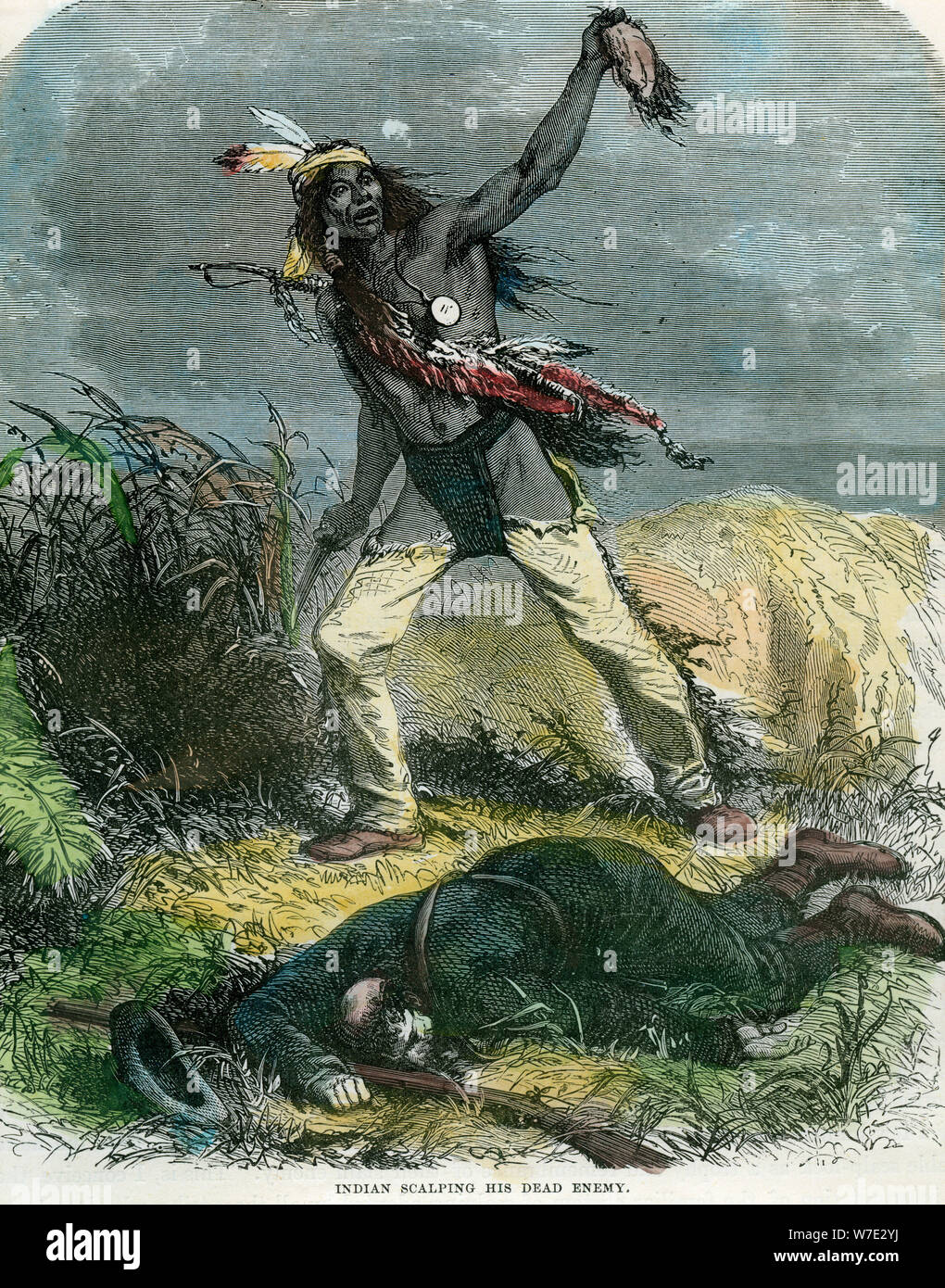 'Indian scalping his dead enemy', 19th century. Artist: Unknown Stock Photohttps://www.alamy.com/image-license-details/?v=1https://www.alamy.com/indian-scalping-his-dead-enemy-19th-century-artist-unknown-image262767782.html
'Indian scalping his dead enemy', 19th century. Artist: Unknown Stock Photohttps://www.alamy.com/image-license-details/?v=1https://www.alamy.com/indian-scalping-his-dead-enemy-19th-century-artist-unknown-image262767782.htmlRMW7E2YJ–'Indian scalping his dead enemy', 19th century. Artist: Unknown
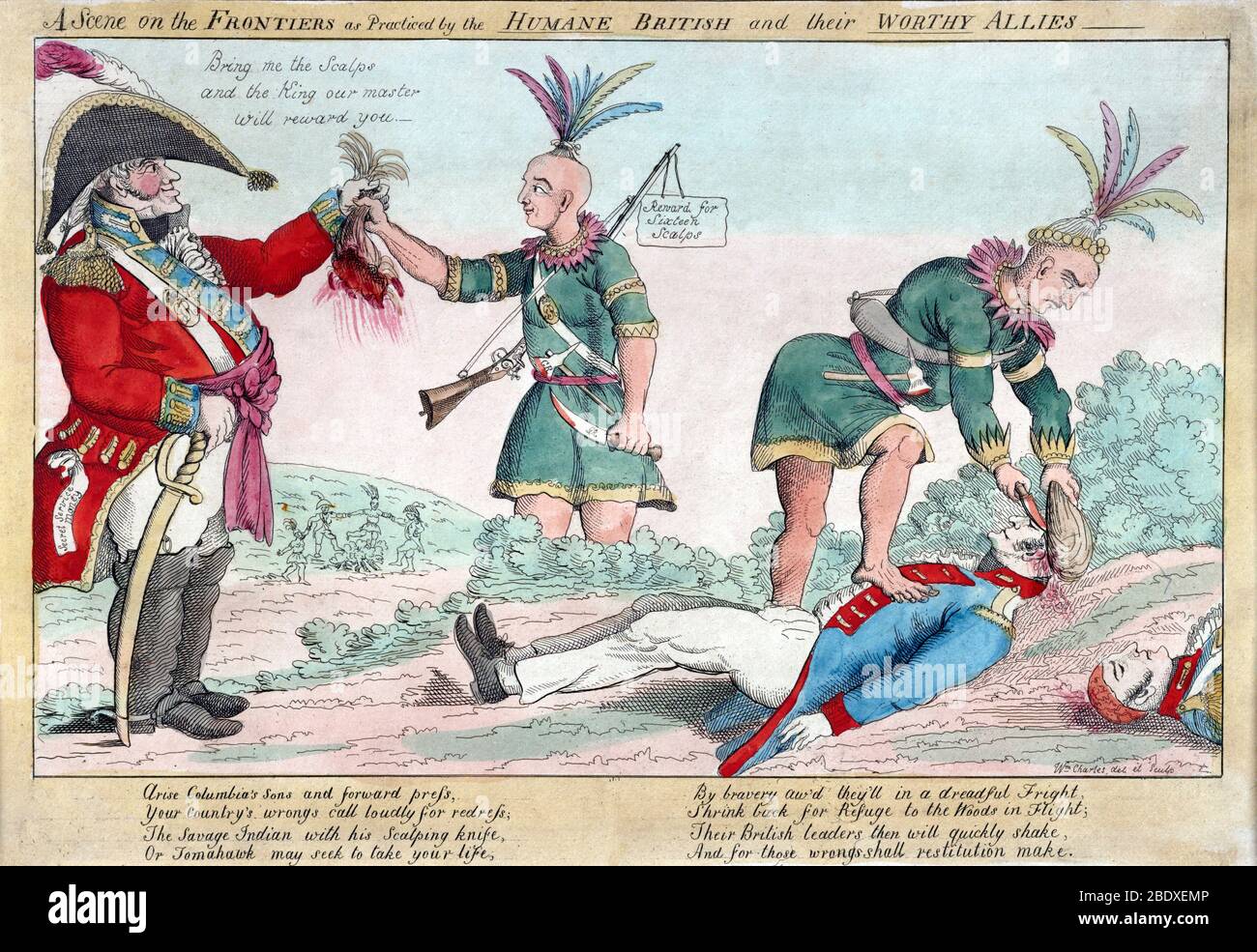 War of 1812, Bounty for American Scalps Stock Photohttps://www.alamy.com/image-license-details/?v=1https://www.alamy.com/war-of-1812-bounty-for-american-scalps-image352780198.html
War of 1812, Bounty for American Scalps Stock Photohttps://www.alamy.com/image-license-details/?v=1https://www.alamy.com/war-of-1812-bounty-for-american-scalps-image352780198.htmlRM2BDXEMP–War of 1812, Bounty for American Scalps
 AVOIDING A SCALPING ? Camouflaged with whiskers is Hollywood comedian JACK OAKIE , seen here in earnest chat with Indian JAMES RED CLOUD during an interval in the filming of ' TOMAHAWK ' . Oakie , a veteran vaudevillian before appearing on the screen , is not camouflaged to avoid scalping for his jokes ; he's merely dressed for his role as an Indian fighter in the picture . 14 December 1950 Stock Photohttps://www.alamy.com/image-license-details/?v=1https://www.alamy.com/avoiding-a-scalping-camouflaged-with-whiskers-is-hollywood-comedian-jack-oakie-seen-here-in-earnest-chat-with-indian-james-red-cloud-during-an-interval-in-the-filming-of-tomahawk-oakie-a-veteran-vaudevillian-before-appearing-on-the-screen-is-not-camouflaged-to-avoid-scalping-for-his-jokes-hes-merely-dressed-for-his-role-as-an-indian-fighter-in-the-picture-14-december-1950-image624407734.html
AVOIDING A SCALPING ? Camouflaged with whiskers is Hollywood comedian JACK OAKIE , seen here in earnest chat with Indian JAMES RED CLOUD during an interval in the filming of ' TOMAHAWK ' . Oakie , a veteran vaudevillian before appearing on the screen , is not camouflaged to avoid scalping for his jokes ; he's merely dressed for his role as an Indian fighter in the picture . 14 December 1950 Stock Photohttps://www.alamy.com/image-license-details/?v=1https://www.alamy.com/avoiding-a-scalping-camouflaged-with-whiskers-is-hollywood-comedian-jack-oakie-seen-here-in-earnest-chat-with-indian-james-red-cloud-during-an-interval-in-the-filming-of-tomahawk-oakie-a-veteran-vaudevillian-before-appearing-on-the-screen-is-not-camouflaged-to-avoid-scalping-for-his-jokes-hes-merely-dressed-for-his-role-as-an-indian-fighter-in-the-picture-14-december-1950-image624407734.htmlRM2Y7T6C6–AVOIDING A SCALPING ? Camouflaged with whiskers is Hollywood comedian JACK OAKIE , seen here in earnest chat with Indian JAMES RED CLOUD during an interval in the filming of ' TOMAHAWK ' . Oakie , a veteran vaudevillian before appearing on the screen , is not camouflaged to avoid scalping for his jokes ; he's merely dressed for his role as an Indian fighter in the picture . 14 December 1950
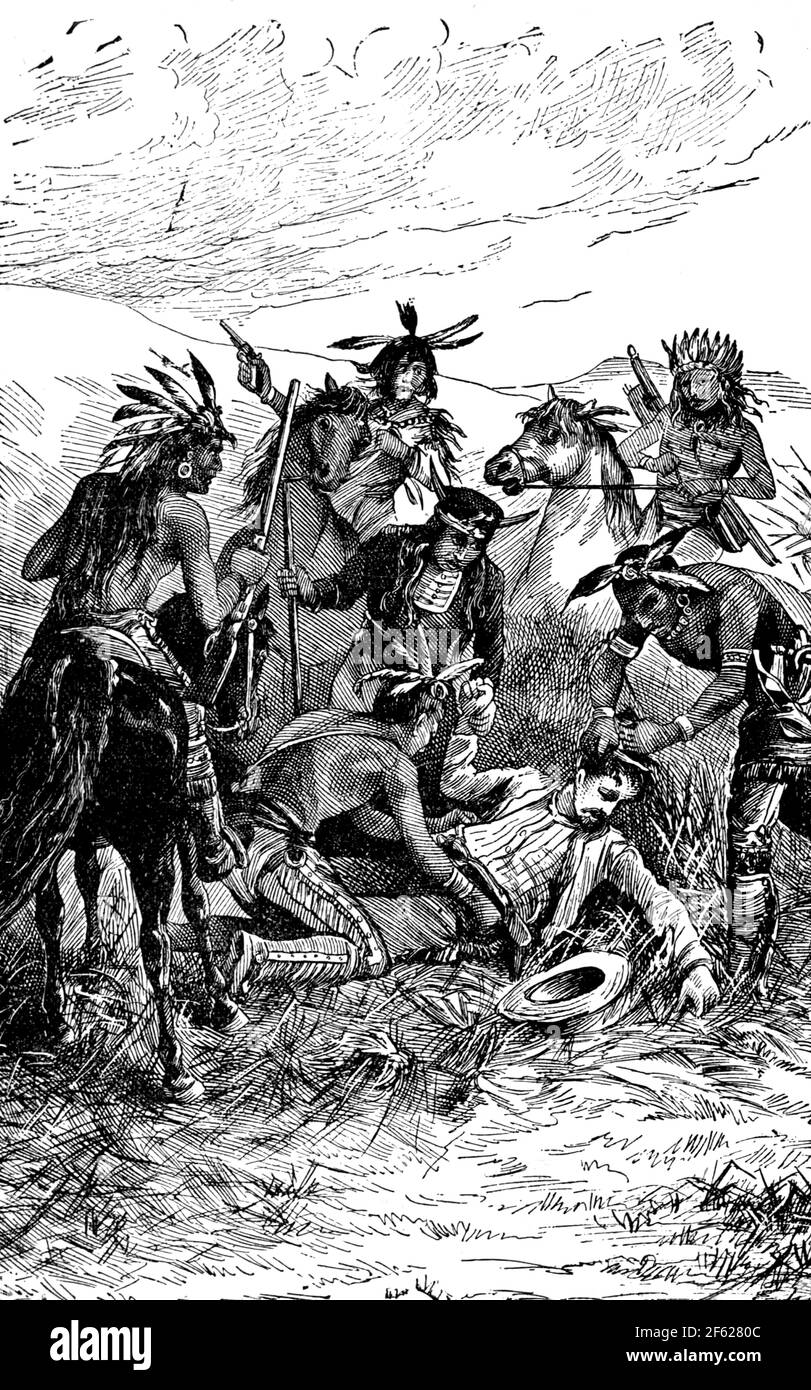 Scalping of Ned Boone, 1780 Stock Photohttps://www.alamy.com/image-license-details/?v=1https://www.alamy.com/scalping-of-ned-boone-1780-image416786956.html
Scalping of Ned Boone, 1780 Stock Photohttps://www.alamy.com/image-license-details/?v=1https://www.alamy.com/scalping-of-ned-boone-1780-image416786956.htmlRM2F6280C–Scalping of Ned Boone, 1780
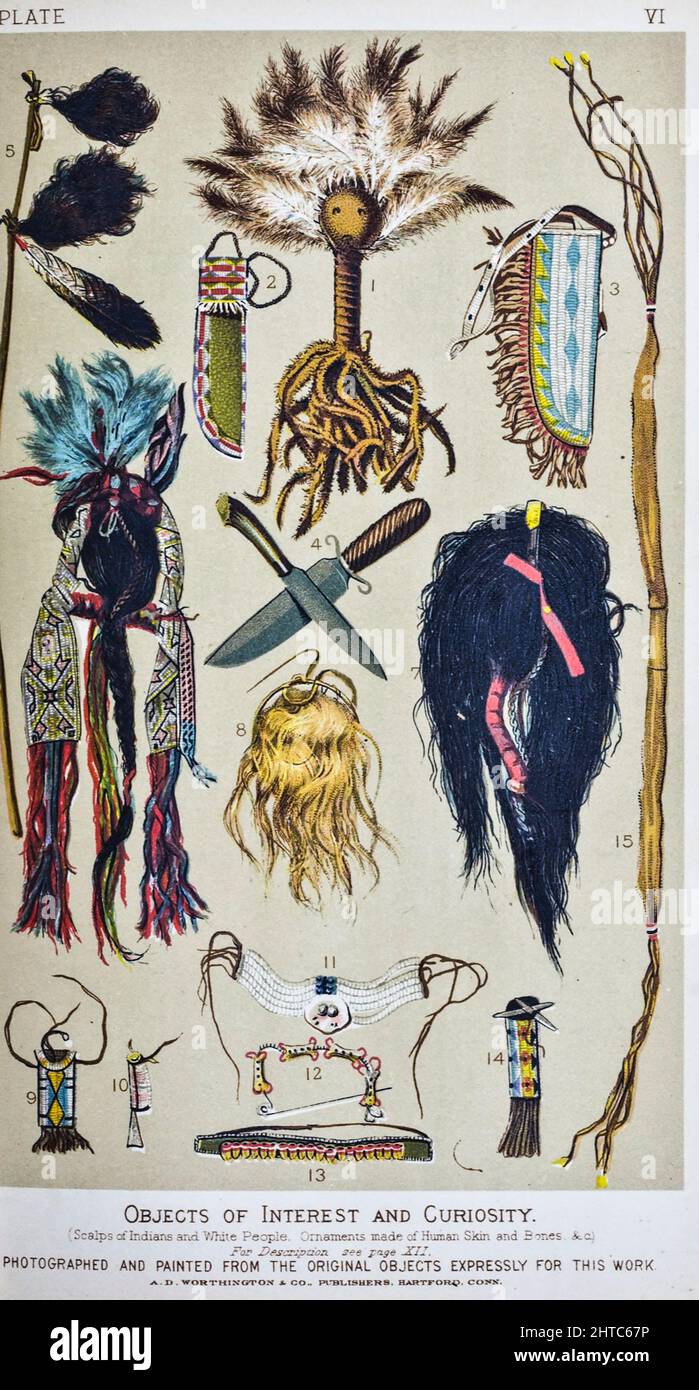 Objects of Interest and Curiosity: Scalps of Indians and White People. Ornaments made of Human Skin and Bones, &c. 1. Kiowa Medicine Rattle. 2. Sheath of Scalping Knife (Sioux). 3. Sheath of Scalping Knife (Cheyenne). 4. Scalping Knives. 5. Scalps of Two White Men, arranged on a Wand fob the Scalp Dance. 6. Scalp of a Sioux Indian. Elaborately ornamented with feathers and beads. 7. Scalp of a Sioux Indian, taken entire. 8. Scalp of a Little White Girl. This scalp was taken from the Comanches. The little girl was about nine years old. 9. Ute Match Safe, Beaded. 10. Ute Needle Case, Beaded. 11. Stock Photohttps://www.alamy.com/image-license-details/?v=1https://www.alamy.com/objects-of-interest-and-curiosity-scalps-of-indians-and-white-people-ornaments-made-of-human-skin-and-bones-c-1-kiowa-medicine-rattle-2-sheath-of-scalping-knife-sioux-3-sheath-of-scalping-knife-cheyenne-4-scalping-knives-5-scalps-of-two-white-men-arranged-on-a-wand-fob-the-scalp-dance-6-scalp-of-a-sioux-indian-elaborately-ornamented-with-feathers-and-beads-7-scalp-of-a-sioux-indian-taken-entire-8-scalp-of-a-little-white-girl-this-scalp-was-taken-from-the-comanches-the-little-girl-was-about-nine-years-old-9-ute-match-safe-beaded-10-ute-needle-case-beaded-11-image462489658.html
Objects of Interest and Curiosity: Scalps of Indians and White People. Ornaments made of Human Skin and Bones, &c. 1. Kiowa Medicine Rattle. 2. Sheath of Scalping Knife (Sioux). 3. Sheath of Scalping Knife (Cheyenne). 4. Scalping Knives. 5. Scalps of Two White Men, arranged on a Wand fob the Scalp Dance. 6. Scalp of a Sioux Indian. Elaborately ornamented with feathers and beads. 7. Scalp of a Sioux Indian, taken entire. 8. Scalp of a Little White Girl. This scalp was taken from the Comanches. The little girl was about nine years old. 9. Ute Match Safe, Beaded. 10. Ute Needle Case, Beaded. 11. Stock Photohttps://www.alamy.com/image-license-details/?v=1https://www.alamy.com/objects-of-interest-and-curiosity-scalps-of-indians-and-white-people-ornaments-made-of-human-skin-and-bones-c-1-kiowa-medicine-rattle-2-sheath-of-scalping-knife-sioux-3-sheath-of-scalping-knife-cheyenne-4-scalping-knives-5-scalps-of-two-white-men-arranged-on-a-wand-fob-the-scalp-dance-6-scalp-of-a-sioux-indian-elaborately-ornamented-with-feathers-and-beads-7-scalp-of-a-sioux-indian-taken-entire-8-scalp-of-a-little-white-girl-this-scalp-was-taken-from-the-comanches-the-little-girl-was-about-nine-years-old-9-ute-match-safe-beaded-10-ute-needle-case-beaded-11-image462489658.htmlRF2HTC67P–Objects of Interest and Curiosity: Scalps of Indians and White People. Ornaments made of Human Skin and Bones, &c. 1. Kiowa Medicine Rattle. 2. Sheath of Scalping Knife (Sioux). 3. Sheath of Scalping Knife (Cheyenne). 4. Scalping Knives. 5. Scalps of Two White Men, arranged on a Wand fob the Scalp Dance. 6. Scalp of a Sioux Indian. Elaborately ornamented with feathers and beads. 7. Scalp of a Sioux Indian, taken entire. 8. Scalp of a Little White Girl. This scalp was taken from the Comanches. The little girl was about nine years old. 9. Ute Match Safe, Beaded. 10. Ute Needle Case, Beaded. 11.
 Modoc War, Modoc Warrior Scalping Soldier, 1873 Stock Photohttps://www.alamy.com/image-license-details/?v=1https://www.alamy.com/modoc-war-modoc-warrior-scalping-soldier-1873-image352780153.html
Modoc War, Modoc Warrior Scalping Soldier, 1873 Stock Photohttps://www.alamy.com/image-license-details/?v=1https://www.alamy.com/modoc-war-modoc-warrior-scalping-soldier-1873-image352780153.htmlRM2BDXEK5–Modoc War, Modoc Warrior Scalping Soldier, 1873
 Guerrier Iroquois. An Iroquois warrior scalping another figure. EncyclopeÌdie des Voyages, contenant l'abreÌgeÌ historique des mÅ“urs ... de tous les peuples: Et la collection complette de leurs habillemens civils, militaires, religieux et dignitaires, dessineÌs d'apreÌ€s nature, ... et colorieÌs aÌ€ l'aquarelle. Paris, 1796. Source: 1259.b.13-17, tom. 5 plate 30. Language: French. Author: GRASSET DE SAINT-SAUVEUR, JACQUES. Stock Photohttps://www.alamy.com/image-license-details/?v=1https://www.alamy.com/guerrier-iroquois-an-iroquois-warrior-scalping-another-figure-encyclopedie-des-voyages-contenant-labrege-historique-des-murs-de-tous-les-peuples-et-la-collection-complette-de-leurs-habillemens-civils-militaires-religieux-et-dignitaires-dessines-dapres-nature-et-colories-a-laquarelle-paris-1796-source-1259b13-17-tom-5-plate-30-language-french-author-grasset-de-saint-sauveur-jacques-image226856695.html
Guerrier Iroquois. An Iroquois warrior scalping another figure. EncyclopeÌdie des Voyages, contenant l'abreÌgeÌ historique des mÅ“urs ... de tous les peuples: Et la collection complette de leurs habillemens civils, militaires, religieux et dignitaires, dessineÌs d'apreÌ€s nature, ... et colorieÌs aÌ€ l'aquarelle. Paris, 1796. Source: 1259.b.13-17, tom. 5 plate 30. Language: French. Author: GRASSET DE SAINT-SAUVEUR, JACQUES. Stock Photohttps://www.alamy.com/image-license-details/?v=1https://www.alamy.com/guerrier-iroquois-an-iroquois-warrior-scalping-another-figure-encyclopedie-des-voyages-contenant-labrege-historique-des-murs-de-tous-les-peuples-et-la-collection-complette-de-leurs-habillemens-civils-militaires-religieux-et-dignitaires-dessines-dapres-nature-et-colories-a-laquarelle-paris-1796-source-1259b13-17-tom-5-plate-30-language-french-author-grasset-de-saint-sauveur-jacques-image226856695.htmlRMR5260R–Guerrier Iroquois. An Iroquois warrior scalping another figure. EncyclopeÌdie des Voyages, contenant l'abreÌgeÌ historique des mÅ“urs ... de tous les peuples: Et la collection complette de leurs habillemens civils, militaires, religieux et dignitaires, dessineÌs d'apreÌ€s nature, ... et colorieÌs aÌ€ l'aquarelle. Paris, 1796. Source: 1259.b.13-17, tom. 5 plate 30. Language: French. Author: GRASSET DE SAINT-SAUVEUR, JACQUES.
 Iroquois Warrior Scalping Enemy, 1814 Stock Photohttps://www.alamy.com/image-license-details/?v=1https://www.alamy.com/stock-photo-iroquois-warrior-scalping-enemy-1814-135089285.html
Iroquois Warrior Scalping Enemy, 1814 Stock Photohttps://www.alamy.com/image-license-details/?v=1https://www.alamy.com/stock-photo-iroquois-warrior-scalping-enemy-1814-135089285.htmlRMHRNRN9–Iroquois Warrior Scalping Enemy, 1814
 Battle scenes of the decorated robe of Mandan second chief Mah-to-toh-pa, Four Bears. Victory over a Cheyenne chief 8, standing alone against a party of Assiniboin 9, scalping two Ojibwe women 10, and shooting an Assiniboin warrior 11. Handcoloured lithograph from George Catlin's Manners, Customs and Condition of the North American Indians, London, 1841. Stock Photohttps://www.alamy.com/image-license-details/?v=1https://www.alamy.com/stock-photo-battle-scenes-of-the-decorated-robe-of-mandan-second-chief-mah-to-84864950.html
Battle scenes of the decorated robe of Mandan second chief Mah-to-toh-pa, Four Bears. Victory over a Cheyenne chief 8, standing alone against a party of Assiniboin 9, scalping two Ojibwe women 10, and shooting an Assiniboin warrior 11. Handcoloured lithograph from George Catlin's Manners, Customs and Condition of the North American Indians, London, 1841. Stock Photohttps://www.alamy.com/image-license-details/?v=1https://www.alamy.com/stock-photo-battle-scenes-of-the-decorated-robe-of-mandan-second-chief-mah-to-84864950.htmlRMEX1X32–Battle scenes of the decorated robe of Mandan second chief Mah-to-toh-pa, Four Bears. Victory over a Cheyenne chief 8, standing alone against a party of Assiniboin 9, scalping two Ojibwe women 10, and shooting an Assiniboin warrior 11. Handcoloured lithograph from George Catlin's Manners, Customs and Condition of the North American Indians, London, 1841.
 Engraving by Flemish engraver Theodore de Bry from a sixteenth century painting by Frenchman Jaques Le Moyne Stock Photohttps://www.alamy.com/image-license-details/?v=1https://www.alamy.com/stock-photo-engraving-by-flemish-engraver-theodore-de-bry-from-a-sixteenth-century-11278740.html
Engraving by Flemish engraver Theodore de Bry from a sixteenth century painting by Frenchman Jaques Le Moyne Stock Photohttps://www.alamy.com/image-license-details/?v=1https://www.alamy.com/stock-photo-engraving-by-flemish-engraver-theodore-de-bry-from-a-sixteenth-century-11278740.htmlRMA5DE9W–Engraving by Flemish engraver Theodore de Bry from a sixteenth century painting by Frenchman Jaques Le Moyne
 Native American warrior taking the scalp of Captain Baker, a gold miner, near the Colorado River. Navajo (?) warrior in feathers, buckskin loincloth and chaps, armed with bow and arrows, holding a scalping knife and scalp. Taken from Illustrated Travels by Henry Walter Bates. Indian scalping his dead enemy. Woodcut from Robert Brown’s The Races of Mankind, Cassell, Petter and Galpin, London, 1873. Stock Photohttps://www.alamy.com/image-license-details/?v=1https://www.alamy.com/native-american-warrior-taking-the-scalp-of-captain-baker-a-gold-miner-near-the-colorado-river-navajo-warrior-in-feathers-buckskin-loincloth-and-chaps-armed-with-bow-and-arrows-holding-a-scalping-knife-and-scalp-taken-from-illustrated-travels-by-henry-walter-bates-indian-scalping-his-dead-enemy-woodcut-from-robert-browns-the-races-of-mankind-cassell-petter-and-galpin-london-1873-image620015470.html
Native American warrior taking the scalp of Captain Baker, a gold miner, near the Colorado River. Navajo (?) warrior in feathers, buckskin loincloth and chaps, armed with bow and arrows, holding a scalping knife and scalp. Taken from Illustrated Travels by Henry Walter Bates. Indian scalping his dead enemy. Woodcut from Robert Brown’s The Races of Mankind, Cassell, Petter and Galpin, London, 1873. Stock Photohttps://www.alamy.com/image-license-details/?v=1https://www.alamy.com/native-american-warrior-taking-the-scalp-of-captain-baker-a-gold-miner-near-the-colorado-river-navajo-warrior-in-feathers-buckskin-loincloth-and-chaps-armed-with-bow-and-arrows-holding-a-scalping-knife-and-scalp-taken-from-illustrated-travels-by-henry-walter-bates-indian-scalping-his-dead-enemy-woodcut-from-robert-browns-the-races-of-mankind-cassell-petter-and-galpin-london-1873-image620015470.htmlRM2Y0M41J–Native American warrior taking the scalp of Captain Baker, a gold miner, near the Colorado River. Navajo (?) warrior in feathers, buckskin loincloth and chaps, armed with bow and arrows, holding a scalping knife and scalp. Taken from Illustrated Travels by Henry Walter Bates. Indian scalping his dead enemy. Woodcut from Robert Brown’s The Races of Mankind, Cassell, Petter and Galpin, London, 1873.
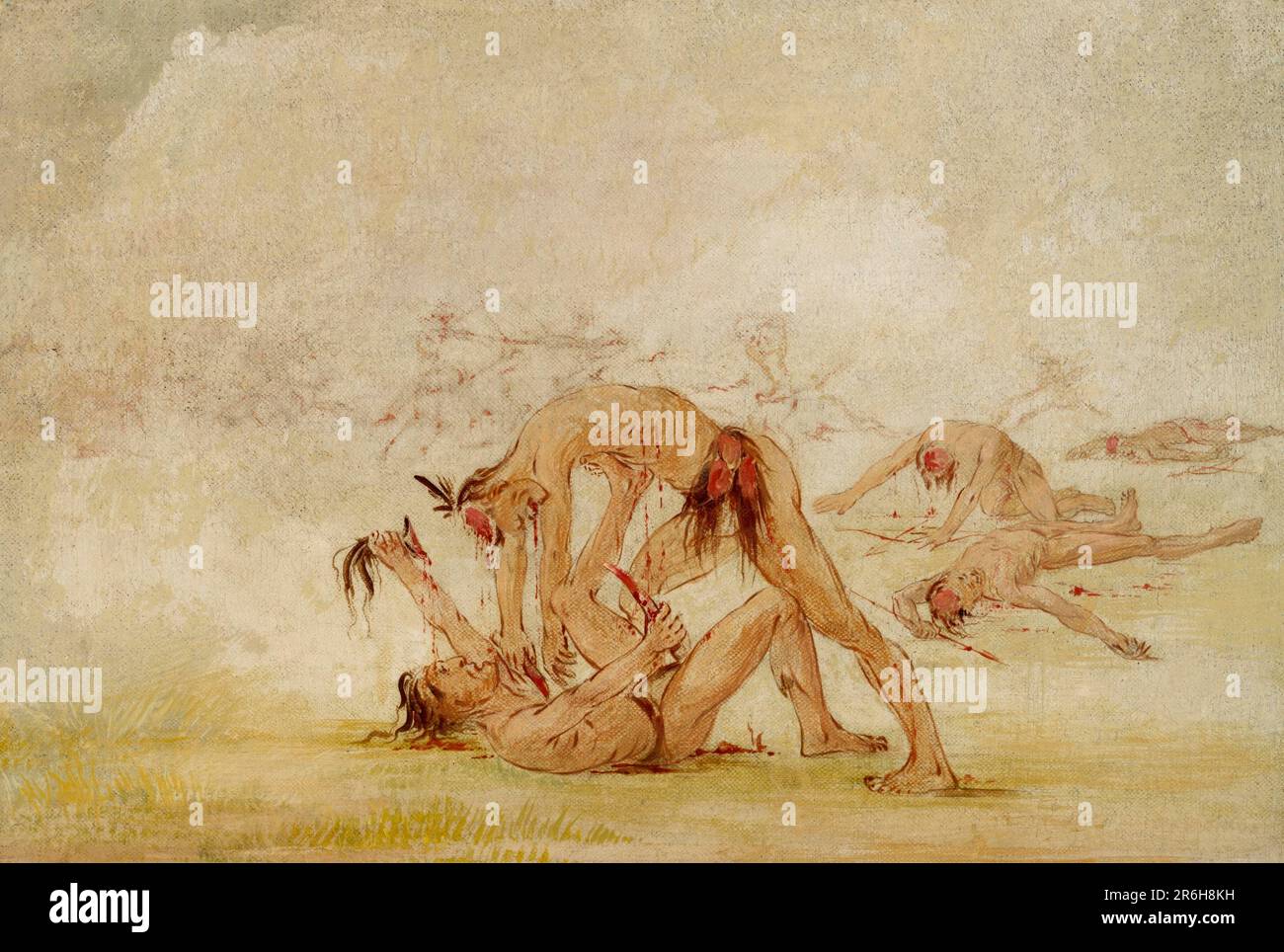 Mandan Scalping an Enemy. oil on canvas. Date: 1835-1837. Museum: Smithsonian American Art Museum. Stock Photohttps://www.alamy.com/image-license-details/?v=1https://www.alamy.com/mandan-scalping-an-enemy-oil-on-canvas-date-1835-1837-museum-smithsonian-american-art-museum-image554799717.html
Mandan Scalping an Enemy. oil on canvas. Date: 1835-1837. Museum: Smithsonian American Art Museum. Stock Photohttps://www.alamy.com/image-license-details/?v=1https://www.alamy.com/mandan-scalping-an-enemy-oil-on-canvas-date-1835-1837-museum-smithsonian-american-art-museum-image554799717.htmlRM2R6H8KH–Mandan Scalping an Enemy. oil on canvas. Date: 1835-1837. Museum: Smithsonian American Art Museum.
 Peter Williamson or Indian Peter (1730-1799), showman in costume of a Delaware Indian in warpaint with tomahawk pipe, feather headdress, musket, scalping knife and animal skin clothes. Aberdeen boy sold into indentured servitude on a Pennsylvania plantation in 1740, kidnapped by Cherokee Indians in 1754 then captured by French troops. Author of the autobiography French and Indian Cruelty, 1756. Portrait copied from The Grand Magazine of June 1759. Lithograph after a stipple engraving by Robert Cooper from Henry Wilson and James Caulfield’s Book of Wonderful Characters, Memoirs and Anecdotes, o Stock Photohttps://www.alamy.com/image-license-details/?v=1https://www.alamy.com/peter-williamson-or-indian-peter-1730-1799-showman-in-costume-of-a-delaware-indian-in-warpaint-with-tomahawk-pipe-feather-headdress-musket-scalping-knife-and-animal-skin-clothes-aberdeen-boy-sold-into-indentured-servitude-on-a-pennsylvania-plantation-in-1740-kidnapped-by-cherokee-indians-in-1754-then-captured-by-french-troops-author-of-the-autobiography-french-and-indian-cruelty-1756-portrait-copied-from-the-grand-magazine-of-june-1759-lithograph-after-a-stipple-engraving-by-robert-cooper-from-henry-wilson-and-james-caulfields-book-of-wonderful-characters-memoirs-and-anecdotes-o-image387949566.html
Peter Williamson or Indian Peter (1730-1799), showman in costume of a Delaware Indian in warpaint with tomahawk pipe, feather headdress, musket, scalping knife and animal skin clothes. Aberdeen boy sold into indentured servitude on a Pennsylvania plantation in 1740, kidnapped by Cherokee Indians in 1754 then captured by French troops. Author of the autobiography French and Indian Cruelty, 1756. Portrait copied from The Grand Magazine of June 1759. Lithograph after a stipple engraving by Robert Cooper from Henry Wilson and James Caulfield’s Book of Wonderful Characters, Memoirs and Anecdotes, o Stock Photohttps://www.alamy.com/image-license-details/?v=1https://www.alamy.com/peter-williamson-or-indian-peter-1730-1799-showman-in-costume-of-a-delaware-indian-in-warpaint-with-tomahawk-pipe-feather-headdress-musket-scalping-knife-and-animal-skin-clothes-aberdeen-boy-sold-into-indentured-servitude-on-a-pennsylvania-plantation-in-1740-kidnapped-by-cherokee-indians-in-1754-then-captured-by-french-troops-author-of-the-autobiography-french-and-indian-cruelty-1756-portrait-copied-from-the-grand-magazine-of-june-1759-lithograph-after-a-stipple-engraving-by-robert-cooper-from-henry-wilson-and-james-caulfields-book-of-wonderful-characters-memoirs-and-anecdotes-o-image387949566.htmlRM2DF4HHJ–Peter Williamson or Indian Peter (1730-1799), showman in costume of a Delaware Indian in warpaint with tomahawk pipe, feather headdress, musket, scalping knife and animal skin clothes. Aberdeen boy sold into indentured servitude on a Pennsylvania plantation in 1740, kidnapped by Cherokee Indians in 1754 then captured by French troops. Author of the autobiography French and Indian Cruelty, 1756. Portrait copied from The Grand Magazine of June 1759. Lithograph after a stipple engraving by Robert Cooper from Henry Wilson and James Caulfield’s Book of Wonderful Characters, Memoirs and Anecdotes, o
 Battle Between Sioux and Sac and Fox, 1846-1848. Stock Photohttps://www.alamy.com/image-license-details/?v=1https://www.alamy.com/battle-between-sioux-and-sac-and-fox-1846-1848-image418815215.html
Battle Between Sioux and Sac and Fox, 1846-1848. Stock Photohttps://www.alamy.com/image-license-details/?v=1https://www.alamy.com/battle-between-sioux-and-sac-and-fox-1846-1848-image418815215.htmlRM2F9AK27–Battle Between Sioux and Sac and Fox, 1846-1848.
![Image taken from page 90 of '[The Peoples of the World: being a popular description of the characteristics, condition, and customs of the human family ... Illustrated. (A new, much enlarged ... edition of The Races of Mankind.)]' Image taken from page 90 of '[The Peoples of the Stock Photo Image taken from page 90 of '[The Peoples of the World: being a popular description of the characteristics, condition, and customs of the human family ... Illustrated. (A new, much enlarged ... edition of The Races of Mankind.)]' Image taken from page 90 of '[The Peoples of the Stock Photo](https://c8.alamy.com/comp/HBTGFR/image-taken-from-page-90-of-the-peoples-of-the-world-being-a-popular-HBTGFR.jpg) Image taken from page 90 of '[The Peoples of the World: being a popular description of the characteristics, condition, and customs of the human family ... Illustrated. (A new, much enlarged ... edition of The Races of Mankind.)]' Image taken from page 90 of '[The Peoples of the Stock Photohttps://www.alamy.com/image-license-details/?v=1https://www.alamy.com/stock-photo-image-taken-from-page-90-of-the-peoples-of-the-world-being-a-popular-127773627.html
Image taken from page 90 of '[The Peoples of the World: being a popular description of the characteristics, condition, and customs of the human family ... Illustrated. (A new, much enlarged ... edition of The Races of Mankind.)]' Image taken from page 90 of '[The Peoples of the Stock Photohttps://www.alamy.com/image-license-details/?v=1https://www.alamy.com/stock-photo-image-taken-from-page-90-of-the-peoples-of-the-world-being-a-popular-127773627.htmlRMHBTGFR–Image taken from page 90 of '[The Peoples of the World: being a popular description of the characteristics, condition, and customs of the human family ... Illustrated. (A new, much enlarged ... edition of The Races of Mankind.)]' Image taken from page 90 of '[The Peoples of the
!['The exultant Indians mutilate the dead body; Passage of the Great Canon of the Colorado', 1875. From, 'Illustrated Travels' by H.W. Bates. [Cassell, Petter, and Galpin, c1880, London] Stock Photo 'The exultant Indians mutilate the dead body; Passage of the Great Canon of the Colorado', 1875. From, 'Illustrated Travels' by H.W. Bates. [Cassell, Petter, and Galpin, c1880, London] Stock Photo](https://c8.alamy.com/comp/2RRJ64F/the-exultant-indians-mutilate-the-dead-body-passage-of-the-great-canon-of-the-colorado-1875-from-illustrated-travels-by-hw-bates-cassell-petter-and-galpin-c1880-london-2RRJ64F.jpg) 'The exultant Indians mutilate the dead body; Passage of the Great Canon of the Colorado', 1875. From, 'Illustrated Travels' by H.W. Bates. [Cassell, Petter, and Galpin, c1880, London] Stock Photohttps://www.alamy.com/image-license-details/?v=1https://www.alamy.com/the-exultant-indians-mutilate-the-dead-body-passage-of-the-great-canon-of-the-colorado-1875-from-illustrated-travels-by-hw-bates-cassell-petter-and-galpin-c1880-london-image565268831.html
'The exultant Indians mutilate the dead body; Passage of the Great Canon of the Colorado', 1875. From, 'Illustrated Travels' by H.W. Bates. [Cassell, Petter, and Galpin, c1880, London] Stock Photohttps://www.alamy.com/image-license-details/?v=1https://www.alamy.com/the-exultant-indians-mutilate-the-dead-body-passage-of-the-great-canon-of-the-colorado-1875-from-illustrated-travels-by-hw-bates-cassell-petter-and-galpin-c1880-london-image565268831.htmlRM2RRJ64F–'The exultant Indians mutilate the dead body; Passage of the Great Canon of the Colorado', 1875. From, 'Illustrated Travels' by H.W. Bates. [Cassell, Petter, and Galpin, c1880, London]
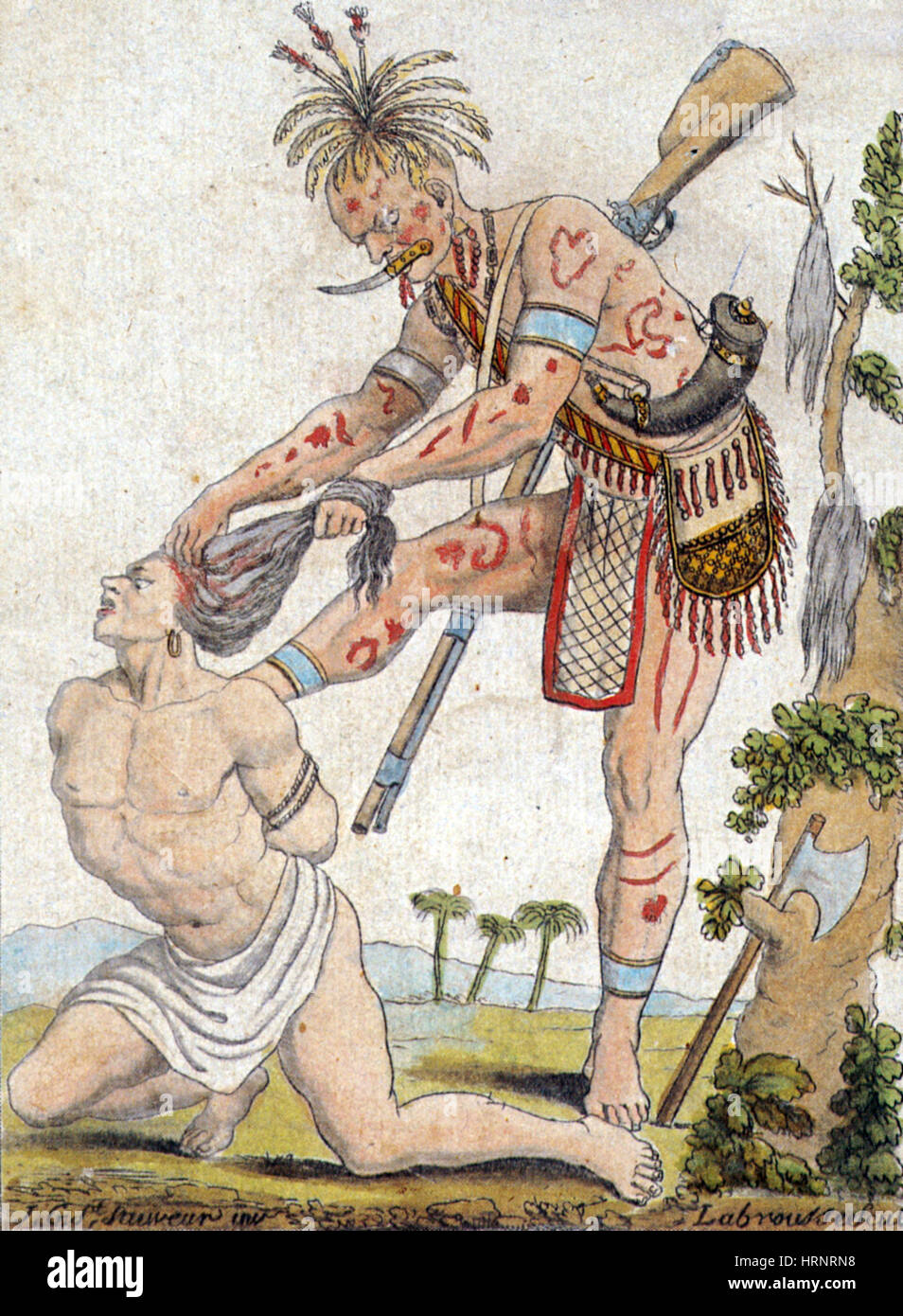 Iroquois Warrior Scalping Enemy, 18th Century Stock Photohttps://www.alamy.com/image-license-details/?v=1https://www.alamy.com/stock-photo-iroquois-warrior-scalping-enemy-18th-century-135089284.html
Iroquois Warrior Scalping Enemy, 18th Century Stock Photohttps://www.alamy.com/image-license-details/?v=1https://www.alamy.com/stock-photo-iroquois-warrior-scalping-enemy-18th-century-135089284.htmlRMHRNRN8–Iroquois Warrior Scalping Enemy, 18th Century
 Daniel Boone Escapes the Shawnee, 1778 Stock Photohttps://www.alamy.com/image-license-details/?v=1https://www.alamy.com/daniel-boone-escapes-the-shawnee-1778-image386296303.html
Daniel Boone Escapes the Shawnee, 1778 Stock Photohttps://www.alamy.com/image-license-details/?v=1https://www.alamy.com/daniel-boone-escapes-the-shawnee-1778-image386296303.htmlRF2DCD8TF–Daniel Boone Escapes the Shawnee, 1778
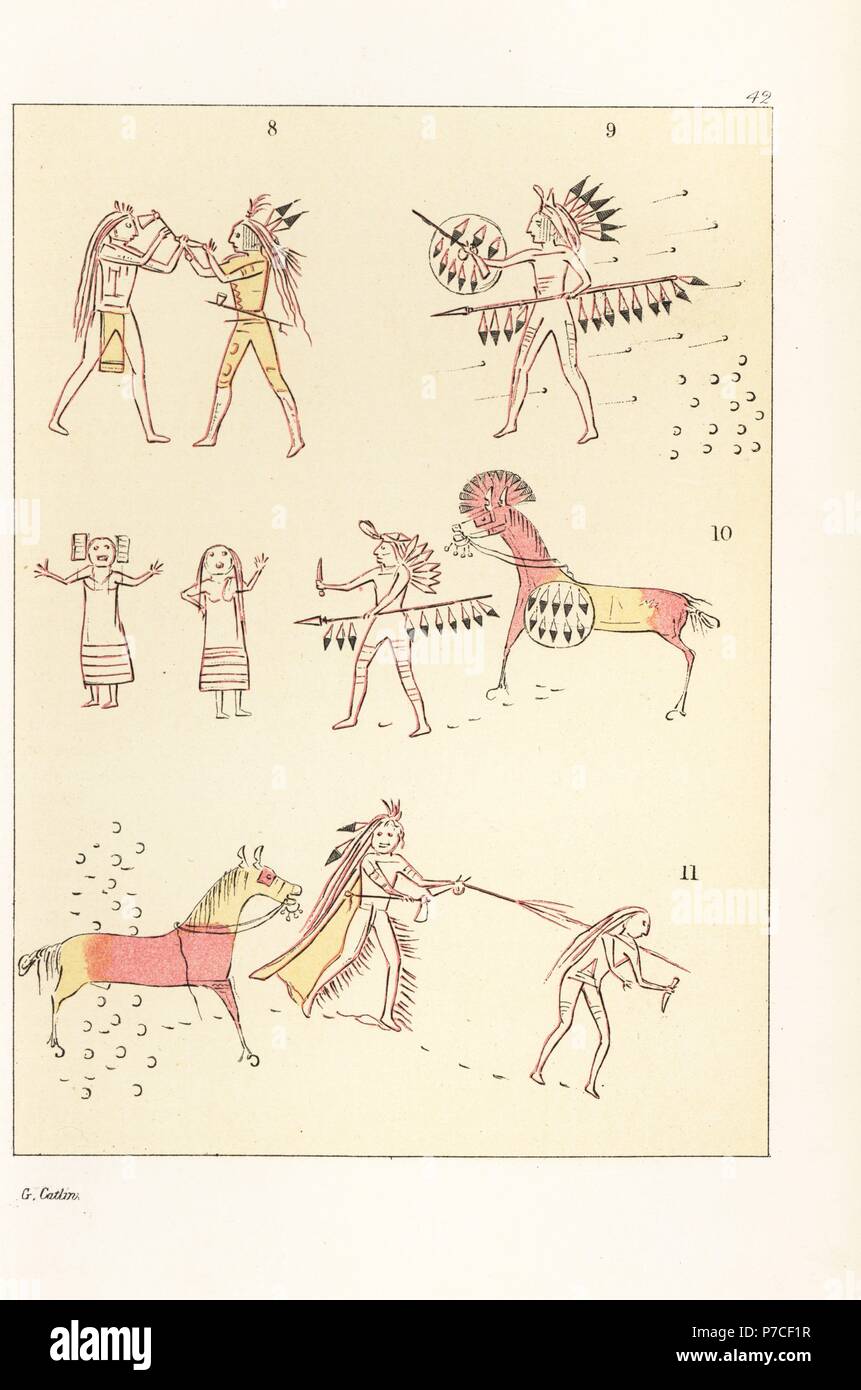 Battle scenes of the decorated robe of Mandan second chief Mah-to-toh-pa, Four Bears. Victory over a Cheyenne chief 8, standing alone against a party of Assiniboin 9, scalping two Ojibwe women 10, and shooting an Assiniboin warrior 11. Handcoloured lithograph from George Catlin's Manners, Customs and Condition of the North American Indians, London, 1841. Stock Photohttps://www.alamy.com/image-license-details/?v=1https://www.alamy.com/battle-scenes-of-the-decorated-robe-of-mandan-second-chief-mah-to-toh-pa-four-bears-victory-over-a-cheyenne-chief-8-standing-alone-against-a-party-of-assiniboin-9-scalping-two-ojibwe-women-10-and-shooting-an-assiniboin-warrior-11-handcoloured-lithograph-from-george-catlins-manners-customs-and-condition-of-the-north-american-indians-london-1841-image211102243.html
Battle scenes of the decorated robe of Mandan second chief Mah-to-toh-pa, Four Bears. Victory over a Cheyenne chief 8, standing alone against a party of Assiniboin 9, scalping two Ojibwe women 10, and shooting an Assiniboin warrior 11. Handcoloured lithograph from George Catlin's Manners, Customs and Condition of the North American Indians, London, 1841. Stock Photohttps://www.alamy.com/image-license-details/?v=1https://www.alamy.com/battle-scenes-of-the-decorated-robe-of-mandan-second-chief-mah-to-toh-pa-four-bears-victory-over-a-cheyenne-chief-8-standing-alone-against-a-party-of-assiniboin-9-scalping-two-ojibwe-women-10-and-shooting-an-assiniboin-warrior-11-handcoloured-lithograph-from-george-catlins-manners-customs-and-condition-of-the-north-american-indians-london-1841-image211102243.htmlRMP7CF1R–Battle scenes of the decorated robe of Mandan second chief Mah-to-toh-pa, Four Bears. Victory over a Cheyenne chief 8, standing alone against a party of Assiniboin 9, scalping two Ojibwe women 10, and shooting an Assiniboin warrior 11. Handcoloured lithograph from George Catlin's Manners, Customs and Condition of the North American Indians, London, 1841.
![The Savages Let Loose, or the Cruel Fate of the Loyalists, 1783. [Is this a Peace, when Loyalists must bleed? It is a Bloody Piece of work indeed]. Stock Photo The Savages Let Loose, or the Cruel Fate of the Loyalists, 1783. [Is this a Peace, when Loyalists must bleed? It is a Bloody Piece of work indeed]. Stock Photo](https://c8.alamy.com/comp/2D6DBXW/the-savages-let-loose-or-the-cruel-fate-of-the-loyalists-1783-is-this-a-peace-when-loyalists-must-bleed-it-is-a-bloody-piece-of-work-indeed-2D6DBXW.jpg) The Savages Let Loose, or the Cruel Fate of the Loyalists, 1783. [Is this a Peace, when Loyalists must bleed? It is a Bloody Piece of work indeed]. Stock Photohttps://www.alamy.com/image-license-details/?v=1https://www.alamy.com/the-savages-let-loose-or-the-cruel-fate-of-the-loyalists-1783-is-this-a-peace-when-loyalists-must-bleed-it-is-a-bloody-piece-of-work-indeed-image382610785.html
The Savages Let Loose, or the Cruel Fate of the Loyalists, 1783. [Is this a Peace, when Loyalists must bleed? It is a Bloody Piece of work indeed]. Stock Photohttps://www.alamy.com/image-license-details/?v=1https://www.alamy.com/the-savages-let-loose-or-the-cruel-fate-of-the-loyalists-1783-is-this-a-peace-when-loyalists-must-bleed-it-is-a-bloody-piece-of-work-indeed-image382610785.htmlRM2D6DBXW–The Savages Let Loose, or the Cruel Fate of the Loyalists, 1783. [Is this a Peace, when Loyalists must bleed? It is a Bloody Piece of work indeed].
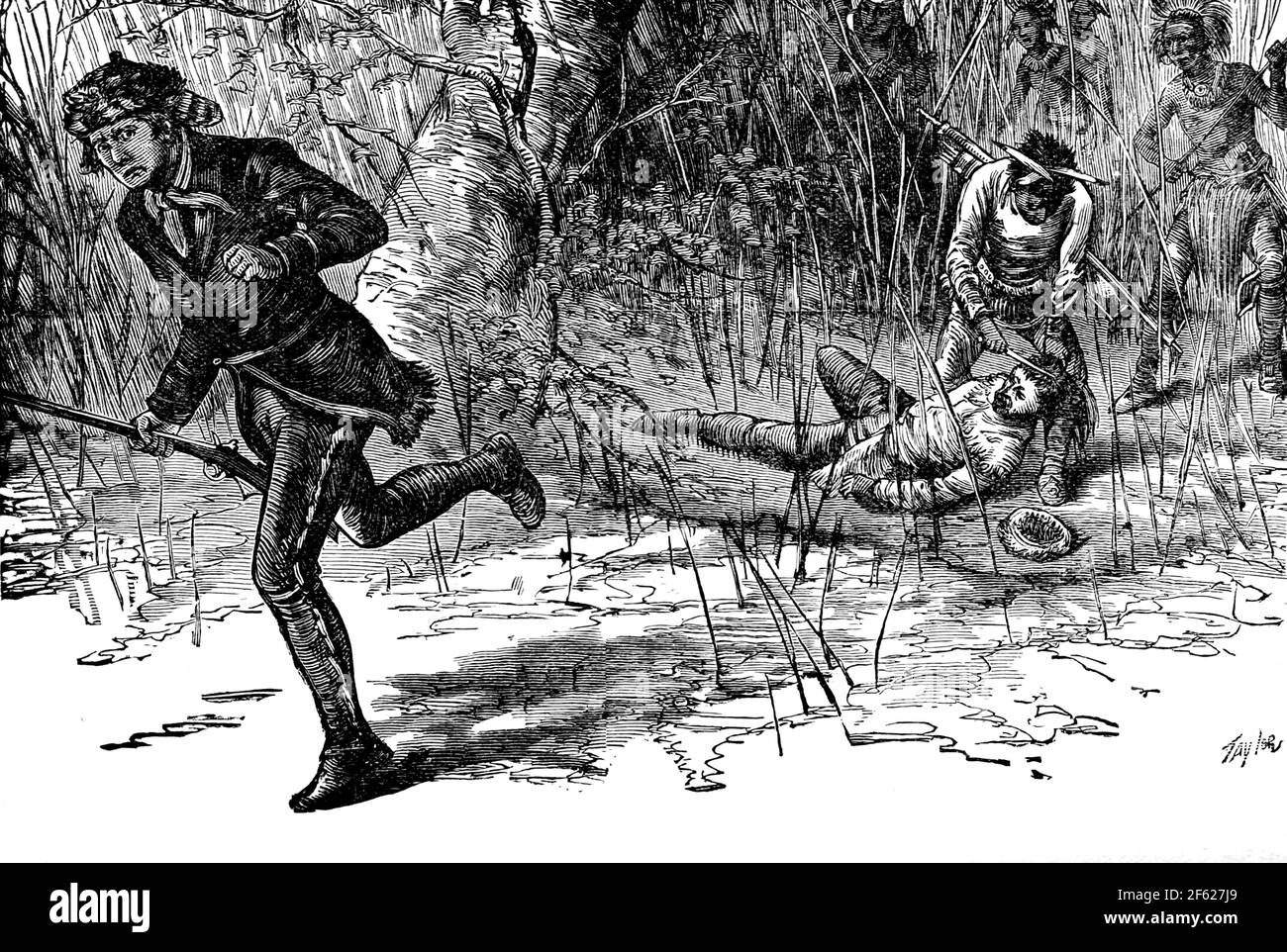 Daniel Boone Escapes the Shawnee, 1778 Stock Photohttps://www.alamy.com/image-license-details/?v=1https://www.alamy.com/daniel-boone-escapes-the-shawnee-1778-image416786673.html
Daniel Boone Escapes the Shawnee, 1778 Stock Photohttps://www.alamy.com/image-license-details/?v=1https://www.alamy.com/daniel-boone-escapes-the-shawnee-1778-image416786673.htmlRM2F627J9–Daniel Boone Escapes the Shawnee, 1778
 Battle Between Sioux and Sac and Fox. oil on canvas. Date: 1846-1848. Museum: Smithsonian American Art Museum. Stock Photohttps://www.alamy.com/image-license-details/?v=1https://www.alamy.com/battle-between-sioux-and-sac-and-fox-oil-on-canvas-date-1846-1848-museum-smithsonian-american-art-museum-image554801234.html
Battle Between Sioux and Sac and Fox. oil on canvas. Date: 1846-1848. Museum: Smithsonian American Art Museum. Stock Photohttps://www.alamy.com/image-license-details/?v=1https://www.alamy.com/battle-between-sioux-and-sac-and-fox-oil-on-canvas-date-1846-1848-museum-smithsonian-american-art-museum-image554801234.htmlRM2R6HAHP–Battle Between Sioux and Sac and Fox. oil on canvas. Date: 1846-1848. Museum: Smithsonian American Art Museum.
 Costumes de Différents Pays, 'Guerrier Iroquois', c1797. Stock Photohttps://www.alamy.com/image-license-details/?v=1https://www.alamy.com/costumes-de-diffxe9rents-pays-guerrier-iroquois-c1797-image571899930.html
Costumes de Différents Pays, 'Guerrier Iroquois', c1797. Stock Photohttps://www.alamy.com/image-license-details/?v=1https://www.alamy.com/costumes-de-diffxe9rents-pays-guerrier-iroquois-c1797-image571899930.htmlRM2T6C85E–Costumes de Différents Pays, 'Guerrier Iroquois', c1797.
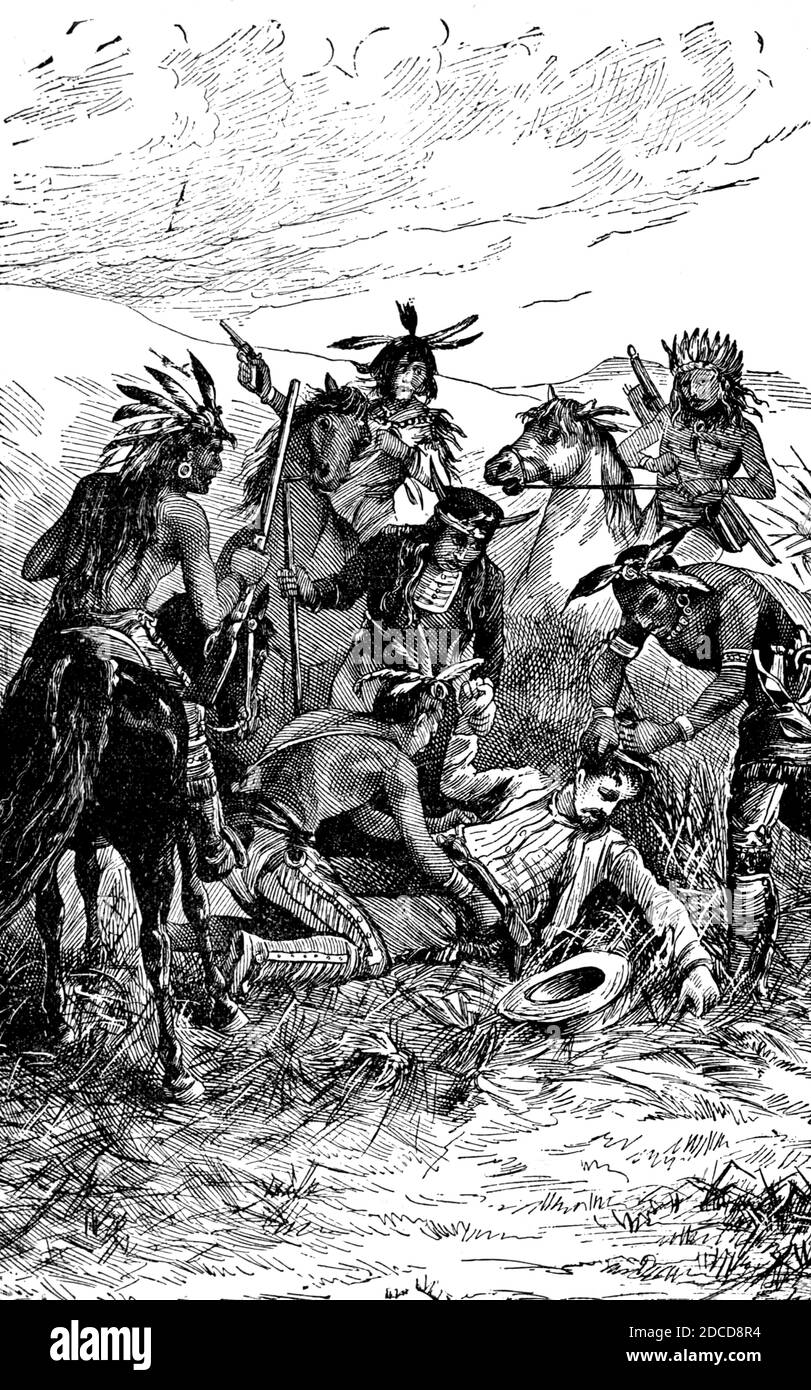 Scalping of Ned Boone, 1780 Stock Photohttps://www.alamy.com/image-license-details/?v=1https://www.alamy.com/scalping-of-ned-boone-1780-image386296264.html
Scalping of Ned Boone, 1780 Stock Photohttps://www.alamy.com/image-license-details/?v=1https://www.alamy.com/scalping-of-ned-boone-1780-image386296264.htmlRF2DCD8R4–Scalping of Ned Boone, 1780
 Peter Williamson or Indian Peter (1730-1799), showman in costume of a Delaware Indian in warpaint with tomahawk pipe, feather headdress, musket, scalping knife and animal skin clothes. Aberdeen boy sold into indentured servitude on a Pennsylvania plantation in 1740, kidnapped by Cherokee Indians in 1754 then captured by French troops. Author of the autobiography French and Indian Cruelty, 1756. Portrait copied from The Grand Magazine of June 1759. Lithograph after a stipple engraving by Robert Cooper from Henry Wilson and James Caulfields Book of Wonderful Characters, Memoirs and Anecdotes, of Stock Photohttps://www.alamy.com/image-license-details/?v=1https://www.alamy.com/peter-williamson-or-indian-peter-1730-1799-showman-in-costume-of-a-delaware-indian-in-warpaint-with-tomahawk-pipe-feather-headdress-musket-scalping-knife-and-animal-skin-clothes-aberdeen-boy-sold-into-indentured-servitude-on-a-pennsylvania-plantation-in-1740-kidnapped-by-cherokee-indians-in-1754-then-captured-by-french-troops-author-of-the-autobiography-french-and-indian-cruelty-1756-portrait-copied-from-the-grand-magazine-of-june-1759-lithograph-after-a-stipple-engraving-by-robert-cooper-from-henry-wilson-and-james-caulfields-book-of-wonderful-characters-memoirs-and-anecdotes-of-image571912464.html
Peter Williamson or Indian Peter (1730-1799), showman in costume of a Delaware Indian in warpaint with tomahawk pipe, feather headdress, musket, scalping knife and animal skin clothes. Aberdeen boy sold into indentured servitude on a Pennsylvania plantation in 1740, kidnapped by Cherokee Indians in 1754 then captured by French troops. Author of the autobiography French and Indian Cruelty, 1756. Portrait copied from The Grand Magazine of June 1759. Lithograph after a stipple engraving by Robert Cooper from Henry Wilson and James Caulfields Book of Wonderful Characters, Memoirs and Anecdotes, of Stock Photohttps://www.alamy.com/image-license-details/?v=1https://www.alamy.com/peter-williamson-or-indian-peter-1730-1799-showman-in-costume-of-a-delaware-indian-in-warpaint-with-tomahawk-pipe-feather-headdress-musket-scalping-knife-and-animal-skin-clothes-aberdeen-boy-sold-into-indentured-servitude-on-a-pennsylvania-plantation-in-1740-kidnapped-by-cherokee-indians-in-1754-then-captured-by-french-troops-author-of-the-autobiography-french-and-indian-cruelty-1756-portrait-copied-from-the-grand-magazine-of-june-1759-lithograph-after-a-stipple-engraving-by-robert-cooper-from-henry-wilson-and-james-caulfields-book-of-wonderful-characters-memoirs-and-anecdotes-of-image571912464.htmlRM2T6CT54–Peter Williamson or Indian Peter (1730-1799), showman in costume of a Delaware Indian in warpaint with tomahawk pipe, feather headdress, musket, scalping knife and animal skin clothes. Aberdeen boy sold into indentured servitude on a Pennsylvania plantation in 1740, kidnapped by Cherokee Indians in 1754 then captured by French troops. Author of the autobiography French and Indian Cruelty, 1756. Portrait copied from The Grand Magazine of June 1759. Lithograph after a stipple engraving by Robert Cooper from Henry Wilson and James Caulfields Book of Wonderful Characters, Memoirs and Anecdotes, of
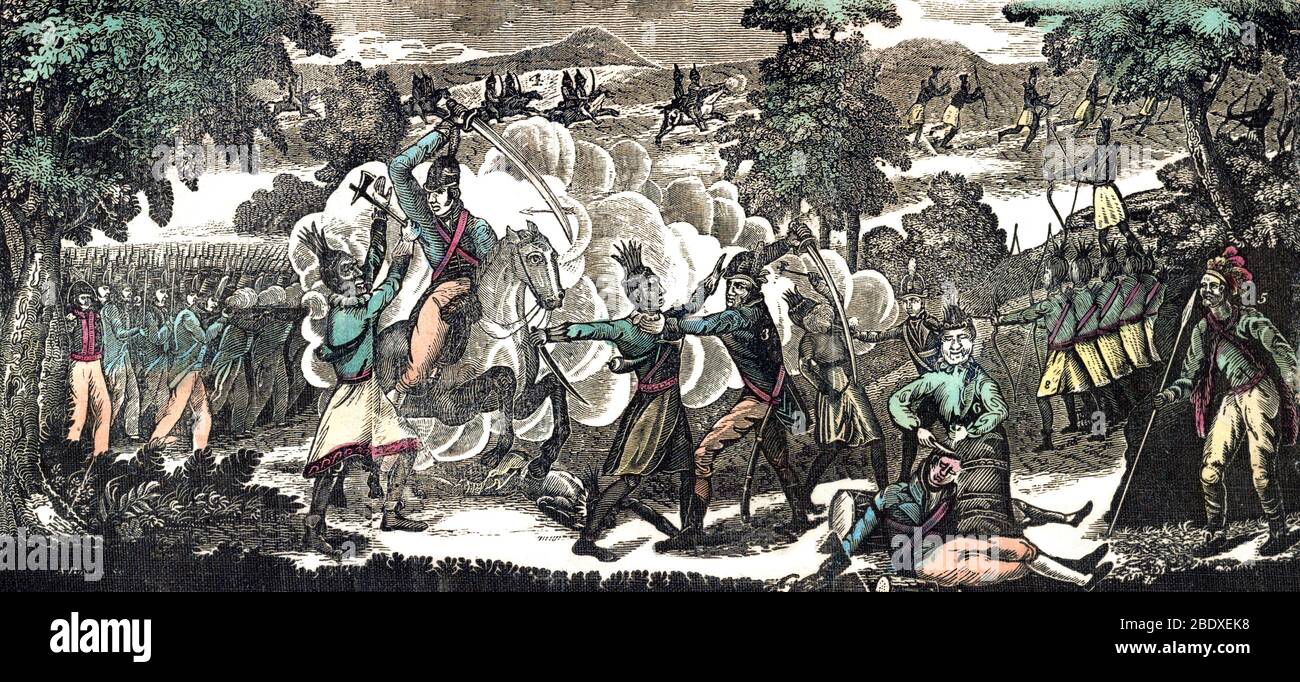 War of 1812, Battle of Thames Stock Photohttps://www.alamy.com/image-license-details/?v=1https://www.alamy.com/war-of-1812-battle-of-thames-image352780156.html
War of 1812, Battle of Thames Stock Photohttps://www.alamy.com/image-license-details/?v=1https://www.alamy.com/war-of-1812-battle-of-thames-image352780156.htmlRM2BDXEK8–War of 1812, Battle of Thames
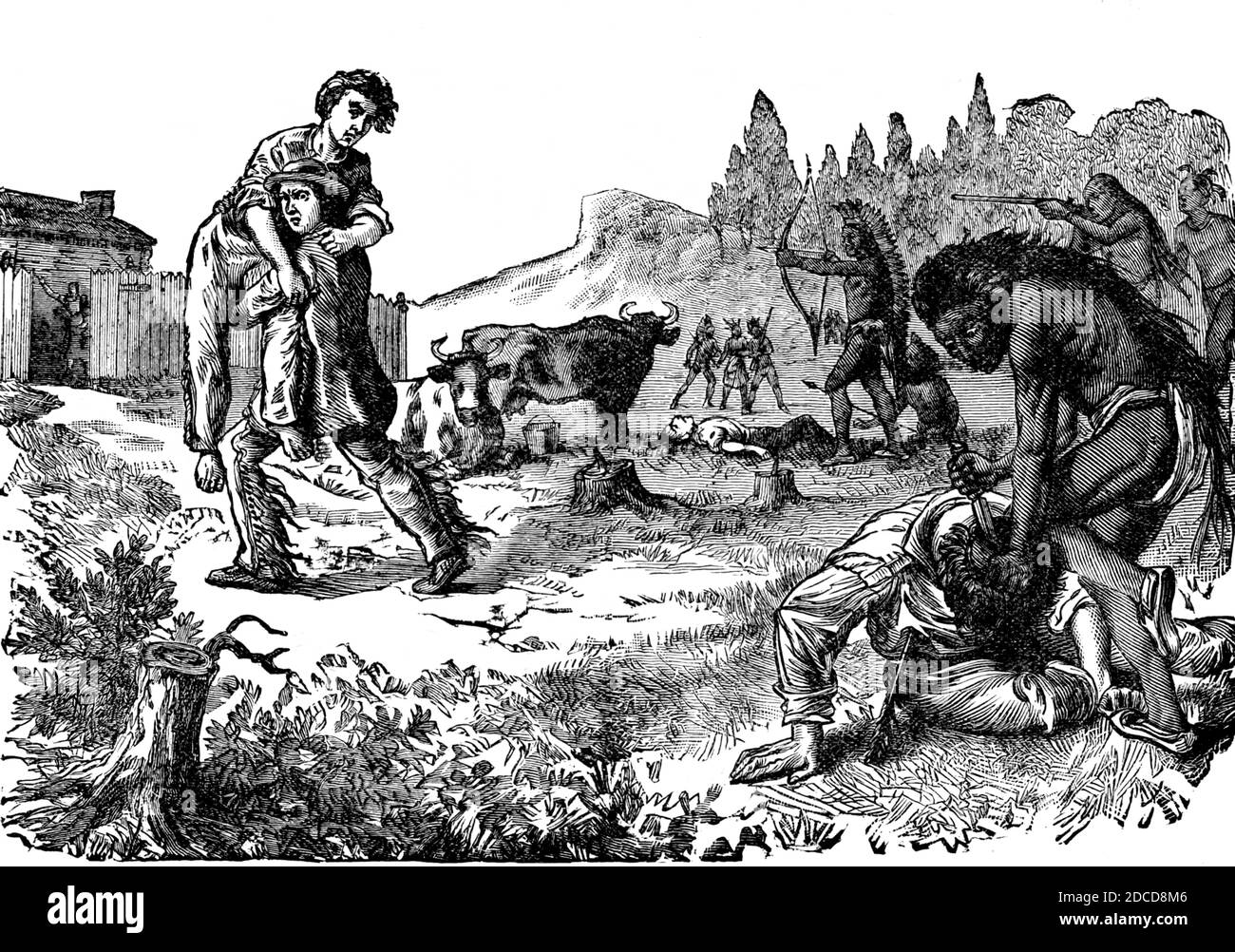 Simon Kenton Rescues Daniel Boone, 1777 Stock Photohttps://www.alamy.com/image-license-details/?v=1https://www.alamy.com/simon-kenton-rescues-daniel-boone-1777-image386296182.html
Simon Kenton Rescues Daniel Boone, 1777 Stock Photohttps://www.alamy.com/image-license-details/?v=1https://www.alamy.com/simon-kenton-rescues-daniel-boone-1777-image386296182.htmlRF2DCD8M6–Simon Kenton Rescues Daniel Boone, 1777
